



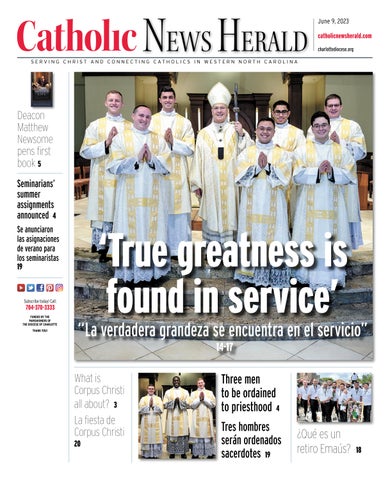




June 9, 2023
Volume 32 • NUMBER 18
1123 S. CHURCH ST. CHARLOTTE, N.C. 28203-4003 catholicnews@charlottediocese.org
704-370-3333
PUBLISHER
The Most Reverend Peter J. Jugis Bishop of Charlotte
Contact us 2 Español 18-20
Our Diocese 4-6
Our Faith 3
Our Schools 8-11
3, 20
22-23
HOST A CORPUS CHRISTI ‘MIRACLE PLAY’
Encourage your children to put together a play depicting a Bible story or a saint to honor of the Feast of Corpus Christi on June 11. In years past, churches would hold a Eucharistic procession followed by “miracle plays” depicting biblical events from creation forward. For this and other ideas for celebrating Corpus Christi as a family, visit https:// blog.holyheroes.com/5-ways-to-celebrate-corpuschristi-as-a-family
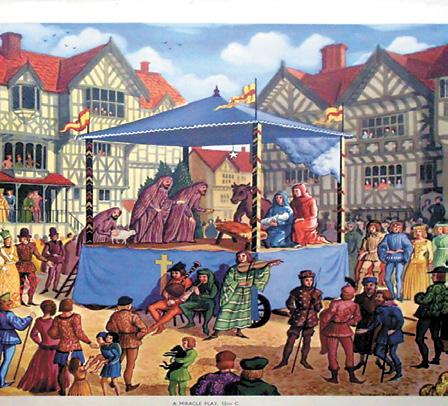
GET TO KNOW THE 108 POLISH
MARTYRS OF WORLD WAR II
In 1999, Pope John Paul II beatified 108 martyrs of World War II during a papal visit to his native Poland. The group of martyrs includes bishops, priests, religious brothers, seminarians, religious sisters and lay people. Their feast day is June 12. Learn more about 10 of these brave martyrs www.epicpew.com/108-polish-martyr. For a complete list, visit www.ucatholic.com/saints/ the-108-martyrs
TAKE A NEARBY PILGRIMAGE
TO HONOR THE SACRED HEART
EDITOR: Spencer K. M. Brown
704-808-4528, skmbrown@charlottediocese.org
ADVERTISING MANAGER: Kevin Eagan
704-370-3332, keeagan@charlottediocese.org
HISPANIC MEDIA MANAGER: César Hurtado
704-370-3375, rchurtado@charlottediocese.org
EDITORIAL TEAM: Kimberly Bender
704-370-3394, kdbender@charlottediocese.org
Annie Ferguson
704-370-3404, arferguson@charlottediocese.org
SueAnn Howell
704-370-3354, sahowell@charlottediocese.org
Troy C. Hull
704-370-3288, tchull@charlottediocese.org
GRAPHIC DESIGNER: Tim Faragher
704-370-3331, tpfaragher@charlottediocese.org
COMMUNICATIONS ASSISTANT/CIRCULATION: Erika Robinson
704-370-3333, catholicnews@charlottediocese.org
COMMUNICATIONS DIRECTOR: Liz Chandler
704-370-3336, lchandler@charlottediocese.org
ASSISTANT COMMUNICATIONS DIRECTOR: Patricia L. Guilfoyle 704-370-3334, plguilfoyle@charlottediocese.org
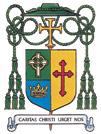
THE CATHOLIC NEWS HERALD is published by the Roman Catholic Diocese of Charlotte 26 times a year.
NEWS: The Catholic News Herald welcomes your news and photos. Please e-mail information, attaching photos in JPG format with a recommended resolution of 150 dpi or higher, to catholicnews@charlottediocese.org. All submitted items become the property of the Catholic News Herald and are subject to reuse, in whole or in part, in print, electronic formats and archives.
ADVERTISING: Reach 165,000 Catholics across western North Carolina! For advertising rates and information, contact Advertising Manager Kevin Eagan at 704-370-3332 or keeagan@charlottediocese.org. The Catholic News Herald reserves the right to reject or cancel advertising for any reason, and does not recommend or guarantee any product, service or benefit claimed by our advertisers.
SUBSCRIPTIONS: $16.75 per year for registered families of the Diocese of Charlotte and $25 per year for all others
POSTMASTER: Periodicals Class postage (USPC 007-393) paid at Charlotte, N.C. Send address corrections to the Catholic News Herald, 1123 S. Church St., Charlotte, N.C. 28203.
In honor of the month dedicated to the Sacred Heart of Jesus and the June 16 solemnity, make an Act of Reparation to the Sacred Heart or simply pray at parishes in Salisbury and Brevard or missions in Burnsville and Wadesboro that bear the patronage of the Sacred Heart of Jesus. It’s a great way to draw closer to Our Lord. For locations: www.charlottediocese.org/parishes. For more about the Solemnity of the Sacred Heart: www. catholicnewsherald.com/faith
LET GOD HELP
In “30 Days to Your New Life: A Guide to Transforming Yourself from Head to Soul,” Anthony DeStefano presents a 30-day program for attaining lifelong peace and fulfillment and eternal happiness in heaven. DeStefano’s path offers genuine hope to everyone and focuses on getting results and breaking out of self-delusion with God’s help. To order: www.sophiainstitute. com/product/30-days-to-your-new-life.

ESPAÑOL
HORA SANTA : 7-8 p.m. Todos los jueves del mes con excepción de los primeros jueves. En la Capilla del segundo piso, Family Life Center en St. Patrick, 1621 Dilworth Road East, Charlotte.
VIÑEDO DE RAQUEL: ¿Es usted o un ser querido que busca la curación de los efectos de un aborto anterior? Los retiros de fin de semana son ofrecidos por Caridades Católicas para hombres y mujeres en todas las regiones de la Diócesis de Charlotte. Para obtener información sobre los próximos retiros, comuníquese con Karina Hernández: 336267-1937 o karinahernandez@live.com.
VIGILIA DE ADORACIÓN: 6 p.m. los jueves, en la Catedral San Patricio, 1621 Dilworth Road East, Charlotte. Nos reunimos para una Vigilia de Adoración por la Paz y la Justiciaen Nicaragua, que en estos últimos meses están pasando por momentos turbulentos y ataques físicos contra la Iglesia Católica, sus templos, y sus Obispos. Todos son bienvenidos a unirse a la Adoración, rezar el Santo Rosario, la hora santa de reparación, y terminando con la oración de exorcismo de San Miguel Arcángel.
PRAYER SERVICES
ST. PEREGRINE HEALING PRAYER : 6-7 p.m. second Thursday of each month in the New Life Center Building adjacent to St. Matthew Church, 8015 Ballantyne Commons Pkwy., Charlotte. St. Peregrine healing prayer service includes a blessing with a relic of St. Peregrine. St. Peregrine has been called the wonder worker for his intercession on behalf of those living with serious illness. He is the patron saint of all who are afflicted by cancer, leg ailments or any life-threatening disease. He is also the patron saint of at-risk youth. All are welcome.
PRO-LIFE ROSARY: After the 9 a.m. Mass every third Sunday at Mother Teresa ProLife Memorial, St. Vincent de Paul Church, 6828 Old Reid Road, Charlotte HOLY APOSTLE AND EVANGELIST LUKE MISSION (UKRAINIAN CATHOLIC CHURCH) : Divine Liturgy (Mass) at 3 p.m. Sundays at St. Barnabas Church, 109 Crescent Hill Road, Arden. For details, email ucmcanton@gmail.com.
Remember to pray for all the fathers in your life on June 18, and beyond. Whether it’s your dad, a spiritual father, or another father figure, prayers to St. Joseph, the foster father of Jesus, are particularly efficacious. For a wonderful resource for prayers and devotions such as the Litany of St. Joseph, daily prayers seeking his intercession, and the Seven Sundays devotion, visit www.yearofstjoseph.org
RACHEL RETREAT: Are you or a loved one seeking healing from the effects of a past abortion? Rachel Retreat weekends are offered by the diocesan Office of Family Life a few times a year for men and women in both English and Spanish. For details, contact Jessica Grabowski: 704-370-3229 or jrgrabowski@rcdoc.org.
TALKS
10TH ANNUAL EAST MEETS WEST RETREAT: Friday-Saturday, June 23-24, St. Barnabas Church, 109 Crescent Hill Road, Arden. A program of Holy Apostle and Evangelist Luke Ukrainian Catholic Mission, the retreat will be led by Dr. Matthew K. Minerd, professor of philosophy and moral theology at Byzantine Catholic Seminary of Sts. Cyril and Methodius in Pittsburgh. He will present three talks based on his book “Made By God, Made For God: Catholic Morality, Explained.” No registration required. Offering suggested. For details, email Father Kevin Bezner at ucmcanton@gmail.com.
His Excellency, Bishop Peter J. Jugis, will participate in the following events:
JUNE 15 – 5 P.M.
Holy Hour for Priesthood Ordinands
St. Patrick Cathedral, Charlotte
JUNE 21 – 6 P.M.
Sacrament of Confirmation
St. Joseph Church, Newton
JUNE 22 – 3 P.M.
SEPI Board Meeting
Virtual
JUNE 23 – 10 A.M.
Parish Pastoral Planning Meeting with St. John the Baptist Church in Tryon Pastoral Center, Charlotte
When most people hear the words “Corpus Christi,” it is the coastal Texas town they might think of first. However, for Catholics, these words have a far deeper meaning.
Corpus Christi Sunday, also known as the Solemnity of the Most Holy Body and Blood of Christ, falls on Sunday, June 11, this year.
Learn more

At www.eucharisticrevival.org : Find Church resources, videos, educational materials, prayers and more at the National Eucharistic Revival movement’s website – designed to restore understanding and devotion to the Eucharist

Each year on this solemn feast, the Church honors Our Lord, celebrating the Real Presence of the Body, Blood, Soul and Divinity of Jesus Christ in the Eucharist.
Corpus Christi is Latin for “Body of Christ.”
The feast day was established in 1246 by Bishop Robert de Thorte of Liege at the suggestion of St. Juliana of Mont Carvillon. It was extended to the universal Church by Pope Urban IV in 1264 after St. Thomas Aquinas, a Doctor of the Church, proposed a feast focused solely on the Holy Eucharist that emphasized the joy of the Real Presence of Jesus. Having recognized in 1264 the authenticity of a Eucharistic miracle in Bolsena, the pontiff, then living in Orvieto, established the feast of Corpus Christi on August 11, 1264, as a solemnity for the whole Roman Catholic Church. The office was composed by St. Thomas Aquinas, and the procession was approved by Popes Martin V and Eugene IV.
Corpus Christi is a “moveable” feast: originally observed on the Thursday after Trinity Sunday. In 1970 it was shifted to the Sunday after Trinity Sunday for U.S. dioceses and most of the world.
On this holy day that honors Our Lord’s Presence in the Eucharist, after Mass Our Lord is placed in a monstrance that is then carried by a priest to four different altars representing the four corners of the earth. While processing, the congregation follows and sings. At each altar there are readings and prayers. The procession is followed by Benediction of the Blessed Sacrament.
Each year in Rome, the pope presides over a Eucharistic procession on the Feast of Corpus Christi. The procession begins at the Archbasilica of St. John Lateran and proceeds to the Basilica of St. Mary Major, where it concludes with Benediction.
Here are a few inspiring quotes from saints about the Body, Blood, Soul and Divinity of Christ.
St. Thomas Aquinas: “The Eucharist is the sacrament of love: it signifies love, it produces love. The Eucharist is the consummation of the whole spiritual life.”
St. Euphrasia: “To speak of the Blessed Sacrament is to speak of what is most sacred. How often, when we are in a state of distress,
JUNE 11-17
Sunday (The Most Holy Body and Blood of Christ): Deuteronomy 8:2-3, 14b-16a, 1 Corinthians 10:16-17, John 6:5158; Monday: 2 Corinthians 1:1-7, Matthew 5:1-12; Tuesday (St. Anthony of Padua):
2 Corinthians 1:18-22, Matthew 5:13-16;
Wednesday: 2 Corinthians 3:4-11, Matthew 5:17-19; Thursday: 2 Corinthians 3:15-4:1, 3-6, Matthew 5:20-26; Friday (The Most Sacred Heart of Jesus): Deuteronomy 7:6-11, 1 John
4:7-16, Matthew 11:25-30; Saturday (The Immaculate Heart of the Blessed Virgin Mary): 2 Corinthians 5:14-21, Luke 2:41-51
those to whom we look for help leave us; or what is worse, add to our affliction by heaping fresh troubles upon us. He is ever there, waiting to help us.”
St. John Chrysostom: “It is not the man who is responsible for the offerings as they become Christ’s Body and Blood; it is Christ Himself who was crucified for us. The standing figure belongs to the priest who speaks these words. The power and the grace belong to God. ‘This is My Body,’ he says. And these words transform the offerings.”
St. Maximilian Kolbe: “If angels could be jealous of men, they would be so for one reason: Holy Communion.”
St. Pio of Pietrelcina: “A thousand years of enjoying human glory is not worth even an hour spent sweetly communing with Jesus in the Blessed Sacrament.”
St. Angela of Foligno: “If we paused for a moment to consider attentively what takes place in this sacrament, I am sure that the thought of Christ’s love for us would transform the coldness of our hearts into a fire of love and gratitude.”
St. Augustine: “What you see is the bread and the chalice; that is what your own eyes report to you. But what your faith obliges you to accept is that the bread is the Body of Christ, and the chalice is the Blood of Christ. This has been said very briefly, which may perhaps be sufficient for faith; yet faith does not desire instruction.”
— Spencer K.M. Brown, Catholic News Herald
Individuals become Christian because they have been touched by Christ’s love, not because they have been convinced or coerced by someone else, Pope Francis said, announcing he will write an apostolic letter dedicated to St. Thérèse of Lisieux.
The Church needs missionary disciples who have hearts like St. Thérèse and who “draw people to love and bring people closer to God,” he told people at his weekly general audience June 7. “Let us ask this saint for the grace to overcome our selfishness and for the passion to intercede that Jesus might be known and loved.”
The pope continued his series of talks about “zeal” for evangelization by focusing on St. Thérèse, the 19thcentury French Carmelite nun who is patron saint of missions and a Doctor of the Church. Before his talk, the pope walked with his cane to a large reliquary containing the relics of St. Thérèse. He placed a large white rose there on the table and stood a few moments in prayer.

He announced he will dedicate an apostolic letter to her to mark the 150th anniversary of her birth this year.
Pope Francis has said he has a special devotion to the saint, once telling an interviewer that he used to keep a photo of this 19th-century French Carmelite nun on his library shelf when he was archbishop of Buenos Aires. He told a journalist in 2010, “When I have a problem I ask the saint, not to solve it, but to take it in her hands and help me accept it, and, as a sign, I almost always receive a white rose.”
During his audience talk, the pope asked Christians to find inspiration in the saint’s life. She lived “according to the way of littleness and weakness,” defining herself as “a small grain of sand.” She had poor health and died at 24, but “her heart was vibrant, missionary,” he said.
JUNE 18-24
Sunday: Exodus 19:2-6a, Romans 5:6-11, Matthew 9:36-10:8; Monday (St. Romuald):
2 Corinthians 6:1-10, Matthew 5:38-42;
Tuesday: 2 Corinthians 8:1-9, Matthew 5:4348; Wednesday (St. Aloysius Gonzaga):
2 Corinthians 9:6-11, Matthew 6:1-6, 16-18; Thursday (St. Paulinus of Nola, Sts. John Fisher and Thomas More): 2 Corinthians 11:1-11, Matthew 6:7-15; Friday: 2 Corinthians 11:18, 21-30, Matthew 6:19-23; Saturday (The Nativity of St. John the Baptist): Isaiah 49:1-6, Acts 13:22-26, Luke 1:57-66, 80
JUNE 25-JULY 1
Sunday: Jeremiah 20:10-13, Romans 5:12-15, Matthew 10:26-33; Monday: Genesis 12:1-9, Matthew 7:1-5; Tuesday (St. Cyril of Alexandria): Genesis 13:2, 5-18, Matthew 7:6, 12-14; Wednesday (St. Irenaeus): Genesis 15:1-12, 17-18, Matthew 7:15-20; Thursday (Sts. Peter & Paul): Acts 12:1-11, 2 Timothy 4:6-8, 17-18, Matthew 16:13-19; Friday (The First Martyrs of the Holy Roman Church): Genesis 17:1, 9-10, 15-22, Matthew 8:1-4; Saturday (St. Junipero Serra): Genesis 18:115, Luke 1:46-50, 53-55, Matthew 8:5-17
The Carmelite nun wanted to be a missionary and served, from her monastery, as a “spiritual sister” to several missionaries, accompanying them through her letters and prayers, he said. “Without being visible, she interceded for the missions, like an engine that, although hidden, gives a vehicle the power to move forward. Such is the power of intercession moved by charity; such is the engine of mission!”
Therefore, missionaries are not only those who “travel long distances, learn new languages, do good works and are good at proclamation,” he said. “No, a missionary is anyone who lives as an instrument of God’s love where they are” so that “through their witness, their prayer, their intercession, Jesus might pass by.”
Apostolic zeal never works with proselytism or coercion. “One does not become a Christian because they are forced by someone, but because they have been touched by love.”
For the latest news 24/7: catholicnewsherald.com
CHARLOTTE —
The Bishop’s Office announces that Vincentian Father Leo Tiburcio, pastor of Our Lady of Guadalupe Parish in Charlotte, has been reassigned by his order. A new pastor is expected to be assigned Aug. 1. Also, effective May 16, Vincentian Father Blas Lemos has been appointed parochial vicar at the parish, joining fellow parochial vicar Vincentian Hugo Medellín.
— Catholic News Herald
CHARLOTTE — The Diocese of Charlotte has named Travis Mack as the new human resources director, effective June 26.
An HR veteran, Mack is a lifelong Catholic with 20 years’ experience in corporate and nonprofit HR environments.
Born and raised in Oregon, Mack holds a bachelor’s degree in business from Oregon State University. He and his wife Kara have four children aged 6 to 15 who attend Catholic schools.

Mack began his career as a recruiter for Nike and has worked in a variety of HR leadership roles at Netflix, Hollywood Entertainment and 24-Hour Fitness. He was on the frontlines of COVID-19, serving as HR manager for Hillsboro Medical Center, a nonprofit community hospital affiliated with one of Oregon’s largest healthcare providers. His experience spans all aspects of human resources, from talent acquisition and onboarding, to compensation and benefits, to employee engagement and executive coaching.
Mack found the Charlotte diocese after a chance meeting with the HR director of the Portland Archdiocese, who in turn got him thinking about putting his skills to work for the Church. After a two-week vacation touring the region last summer, including a stay at Lake Norman, he was sold on the Charlotte area.
“You can’t imagine how many things had to fall into place for me to find Charlotte, and then find the Charlotte diocese,” Mack said. “This is a wonderful opportunity that I believe truly is meant to be. My hope now is to bring my energy and expertise to elevate what we do at the diocese – and to help the Church accomplish her mission.”
(Pictured from left) Deacons Christopher Brock, Chinonso Nnebe-Agumadu and Peter Rusciolelli are pictured here at their diaconate ordination in 2022. Join in praying for these men as they prepare for their ordination to the priesthood.

FILE | CATHOLIC NEWS HERALD
CHARLOTTE — Thirty Diocese of Charlotte seminarians have been assigned to work at parishes this summer. They will serve from Saturday, June 3, to Sunday, Aug. 6. Seminarians and their assignments are:
n Clement Akerblom: St. John the Evangelist Parish in Waynesville
n Christopher Angermeyer: Our Lady of Grace Parish in Greensboro
n Robert Bauman: Our Lady of Mercy Parish in Winston-Salem
n Michael Camilleri: St. Jude Parish in Sapphire
n John Cuppett: St. Margaret Mary Parish in Swannanoa
n Anthony del Cid Lucero: Immaculate Conception Parish in Hendersonville
n Matthew Dimock Jr.: St. Mark Parish in Huntersville
n Kolbe Flood: St. Bernadette Parish in Linville
n Maximilian Frei: St. John the Evangelist Parish in Waynesville
n Christian Goduti: Holy Cross Parish in Kernersville
SPENCER
K.M. BROWN skmbrown@charlottediocese.orgCHARLOTTE — Deacons Christopher Brock, Chinonso Nnebe-Agumadu and Peter Rusciolelli will be ordained to the priesthood June 17 at St. Mark Church in Huntersville by Atlanta Archbishop Gregory Hartmayer, OFM Conv.
Amid an ongoing health concern, Bishop Peter Jugis announced June 1 he will not officiate at the Diocese of Charlotte’s ordination liturgies, which instead will be celebrated by the archbishop.
Bishop Jugis said he has been dealing with an “evolving health issue” and that medical tests recently revealed he has only one functioning kidney. His condition, he said, “is not life threatening but at times affects my ability to travel or participate in long liturgies and other occasions.”
At the bishop’s request, Archbishop Hartmayer presided at the June 3 diaconate ordination of seven seminarians and will also preside at the June 17 ordination of three men to the priesthood.
It was a little over a year ago that Bishop Jugis began experiencing symptoms that prevented him from presiding at some occasions, including the ordination Masses last June. Archbishop Hartmayer assisted by presiding over one of those liturgies: the ordination to deacon of Christopher Brock, Chinonso Nnebe-Agumadu and Peter Rusciolelli. Archbishop Hartmayer now returns to ordain them as priests.
The three young men all recently received their Master of Divinity from Mount St. Mary’s Seminary & School of Theology in Cincinnati, Ohio, the final academic step of their formation.
As ordination approaches, Deacon Rusciolelli, whose home parish is St. Patrick Cathedral in Charlotte, said, “I am very excited for my ordination day as it is something I have been anticipating, thinking and praying about for a long time. I am extremely grateful for the graces Our Lord has given me to follow His holy will, as well as for all those who have supported me in so many ways during these years.”
For Deacon Brock, whose home parish is St. Vincent de Paul in Charlotte, there is a lot of excitement in the days leading up to ordination. “When I entered seminary six years ago, I did so because I believed God was calling me to be a priest, and so seeing my ordination day just around the corner is very joyful and exciting.”
Deacon Nnebe-Agumadu, whose home parish is St. Thomas Aquinas in Charlotte, added, “I’m nervous because this is not an easy task, but I’m excited to see how God will use me as His priest in the mission of giving Him glory and drawing souls to Him. As this great day approaches, I can’t help but look back at the formation I have received these past six years and trust that they have prepared me well for the life ahead.”
After their ordination, all three will serve as priests of the Diocese of Charlotte. Their first pastoral assignments will be announced at the end of the ordination Mass.
All are welcome to attend the 10 a.m. Mass Saturday, June 17, at St. Mark Church, located at 14740 Stumptown Road in Huntersville.
Following their ordination to the priesthood June 17, the new priests will offer first Masses at their home parishes. All are invited to attend.
Deacon Christopher Brock will offer his first Mass of Thanksgiving at 11:30 a.m. Sunday, June 18, at St. Vincent de Paul Church in Charlotte. A reception will follow in the Monsignor Pharr Activity Center.
Deacon Chinonso Nnebe-Agumadu will offer his first Mass of Thanksgiving at 2 p.m. Sunday, June 18, at St. Thomas Aquinas Church in Charlotte. Mass will be followed by a parish potluck and reception.
Deacon Peter Rusciolelli will offer his first Mass of Thanksgiving at 9 a.m. Sunday, June 18, at St. Patrick Cathedral in Charlotte. A reception will follow in the Family Life Center.
n Matthew Harrison II: St. Leo the Great Parish in Winston-Salem
n Bryan Ilagor: Immaculate Conception Parish in Hendersonville
n James Johnson IV: St. Gabriel Parish in Charlotte
n Nicholas Kramer: St. John the Baptist Parish in Tryon
n Bradley Loftin: St. John the Baptist Parish in Tryon
n Michael Lugo: St. Bernadette Parish in Linville
n Luke Martin: Sacred Heart Parish in Salisbury
n Patrick Martin: Queen of the Apostles Parish in Belmont
n Emanuel Martinez: St. Thomas Aquinas Parish in Charlotte
n Kevin Martinez: St. Thomas Aquinas Parish in Charlotte
n Kolbe Murrey: St. Ann Parish in Charlotte
n José Palma Torres: St. Ann Parish in Charlotte
n Elliott Suttle: St. Mary Help of Christians Parish in Shelby

n Andrew Templeton: St. Mark Parish in Huntersville
n Peter Townsend: St. Mark Parish in Huntersville
n Kevin Tran: St. Michael the Archangel Parish in Gastonia
n James Tweed: St. Jude Parish in Sapphire
n Bailey Van Nosdall: St. Leo the Great Parish in Winston-Salem
n Connor White: Holy Cross Parish in Kernersville
n Joseph Yellico: St. Margaret Mary Parish in Swannanoa
— Catholic News Herald
 ANNIE FERGUSON arferguson@charlottediocese.org
ANNIE FERGUSON arferguson@charlottediocese.org
Devotion is a central theme in Deacon Matthew Newsome’s life. He is especially devoted to his wife and their seven children, his ministry, and God. It’s also a key component of his writing, a decadeslong endeavor now experiencing a fresh flowering with the publication of his first book, “The Devout Life: A Modern Guide to Practical Holiness with St. Francis de Sales” to be released June 20 by Sophia Institute Press.
“I’m very excited by it,” he said. “Ever since I was a kid, I’ve always wanted to be a published author.”
Deacon Newsome writes a regular column for the Catholic News Herald, and his articles have appeared in other Catholic publications including The Deacon, This Rock (now Catholic Answers Magazine) and Envoy. He is the Catholic campus minister at Western Carolina University, and his home parish is St. Mary Mother of God in Sylva.
As an adult convert to the Catholic faith, he said he never would have guessed his first book would be about St. Francis de Sales, a 17th-century bishop he credits with being 300 years ahead of the Universal Call to Holiness promulgated by Pope Paul VI in 1964.
In “An Introduction to the Devout Life,” first published in 1609, St. Francis de Sales gives practical advice to attain holiness in ways that fit the lives of laypeople. Deacon Newsome’s book takes the saint’s teachings from this spiritual classic and applies them to Catholics in the 21st century.
“St. Francis de Sales has a lot of wisdom, and how many people aren’t reading it because they don’t think that they can pick up and read a 400-year-old book by a French bishop?” Deacon Newsome said.
Like the original, the book is
“An Introduction to the Devout Life,” and they started reading it together for the first time.
“St. Francis de Sales was most famous for his down-to-earth homilies that explained the complexities of the Christian faith in simple ways the people of his age could understand,” Deacon Newsome said, “and that came through in his writing as well.”
As they went through the book, Deacon Newsome said he did a fair amount of translating in the sense of culture and context. That’s when Joannie suggested that he write a book so he could help others understand the teachings more thoroughly as well. A prolific reader who has taught grammar and writing to their homeschooled children for years, she also worked with her husband to refine the manuscript and write the discussion questions.
SPENCER K.M. BROWN skmbrown@charlottediocese.orgCHARLOTTE — Eleven college students who are Catholic parishioners in North Carolina each have been awarded a $2,000 scholarship from the George Pitman Endowment Fund.
The endowment was established by the late George Warren Pitman, a successful entrepreneur and philanthropist who once lived in Charlotte. He made the scholarships available to applicants who reside in either Mecklenburg County or the town of Dunn.
organized in five sections that Deacon Newsome likens to the Parable of the Sower. The book starts by helping readers “prepare the soil of their hearts” and progresses through the planting, growing and tending of their spiritual gardens with practical advice for incorporating prayer into their daily lives and growing in virtues. Each chapter is short and accessible with discussion questions at the end.
“The person who is going to benefit from this book the most is someone who is already a committed Catholic,” Deacon Newsome said. “They’re going to Mass. They’re committed to the faith, but they’re looking for the next step. They might not be satisfied with just being a Sunday Catholic.”
The inspiration for Deacon Newsome’s book on the saintly French bishop surfaced four years ago as he and his wife Joannie were seeking to increase their own holiness. They were looking for a devotional book to read after their evening prayers. Deacon Newsome recommended
“My wife is the best editor I know,” Deacon Newsome said, noting they worked in tandem throughout the writing process.
Authoring an update to a spiritual classic is a notable first foray into book publishing for anyone, but the seeds of “The Devout Life” were planted long ago.
“For the past 15 years I’ve been working in campus ministry helping young adults understand and appropriate the faith and put it into practice,” Deacon Newsome said. “I’ve worked as part of our lay ministry program. I’ve engaged in catechist training. My whole vocation, my whole work is helping people to understand these things, but it’s very humbling to think that I could update a saint because I am not a saint.”
If you’re looking for your next read, consider taking one step closer to ‘The Devout Life’ with Deacon Newsome.
Order a copy of “The Devout Life” at www. sophiainstitute.com/product/the-devout-life
Pitman, a renowned designer, built a successful business in the Carolinas and Virginia before passing away in 2007 at the age of 79. For more than 30 years, he ran his design firm, George Pitman Inc., from his home in Charlotte’s Myers Park neighborhood. He was a graduate of Mount St. Mary’s College in Emmitsburg, Md., and Bright’s School of Design in Chicago, and he bequeathed $1.2 million of his estate to establish an endowment that funds need-based scholarships to Catholic students who wish to earn an undergraduate degree.
Through the George Warren Pitman Scholarship Fund, college-bound Catholics can apply for renewable awards of up to $2,000, depending on the type of college (two-year, four-year or vocational) they plan to attend.
Of the 11 students, five are first-time recipients. They will attend universities including: Appalachian State University, The Catholic University of America, N.C. State University, UNC-Chapel Hill, the University of Tennessee, and Washington & Lee University.
“Mr. Pitman’s transformative gift continues to benefit Catholic students to attend a college or university of their choice,” Jim Kelley said, development director for the Diocese of Charlotte.
He added, “More and more people across the diocese are remembering the Church in their estate plans, and we are thankful for their generosity.”
To date, the Pitman Scholarship has awarded $111,000 since its inception in 2018.
Those like Pitman who make a planned gift that benefits the diocese or any of its parishes, schools, ministries or agencies become members of the Catholic Heritage Society. The Catholic Heritage Society is comprised of more than 1,600 people in the diocese, many of whom are leaving gifts to the diocesan foundation in their wills.
Since 1994, the foundation has distributed $14.7 million to the diocese and its parishes, schools and ministries.


CHARLOTTE — More than 100 people attended the Diocese of Charlotte’s annual Memorial Day Mass May 29 at St. Patrick Cathedral. Father Christopher Roux, rector of the cathedral, noted that praying for the dead is an important obligation for Catholics – especially so on Memorial Day.
“We celebrate this day in honor of those who gave their lives for the freedoms we enjoy,” he said. He encouraged people “to pray for the happy repose of their souls,” as well as to pray for those who criticize the United States and reject American values.
“We must witness the love of country,” he said, and teach young people about the importance of the freedoms that this country stands for.
— Patricia L. Guilfoyle
The application period for the George Pitman Scholarship runs from Dec. 3 to March 1 annually. For application information, contact Jim Kelley, development director for the Diocese of Charlotte, at jkkelley@rcdoc.org.
CHARLOTTE — Deacon Bernard William Wenning Jr. passed away May 16, 2023. He was 87.
The funeral Mass was celebrated May 25, 2023, at St. Gabriel Catholic Church in Charlotte.
He was born Sept. 4, 1935, and grew up in West Long Branch, N.J., living there until he was 21 years old. He graduated from Red Bank Catholic High School in 1954. He initially worked for William’s Sign Painting in West Long Branch until he joined the U.S. Navy in 1955. He was stationed at Boeing Air Force Base in Washington, D.C., for four years.
He married his bride, Dot, in 1957. In 1963, the family moved to Vienna, Va., where he volunteered with the Vienna Volunteer Fire Department and served as its president for several years. He worked for the Federal Aviation Administration as an air traffic controller at both Dulles International Airport and Reagan National Airport in Washington, D.C. In 1978, the family moved to Charlotte when Ben accepted the position of Deputy Chief of the Tower at Charlotte Douglas International Airport. He worked in that capacity until his retirement.
On June 18, 1988, he was ordained a permanent deacon for the Diocese of Charlotte at St. Gabriel Church, and it was at that parish that he began his ministry as a deacon. He served in that calling for 22 years.
In 1990, Deacon Wenning was the first deacon assigned to the Airport Chaplaincy at Charlotte Douglas International Airport, serving on the Airport Chaplaincy Board. It was then that he also started to take on diocesan responsibilities. As the ministry of permanent deacons evolved, Deacon Wenning served as assistant director of post ordination affairs, as vicar of the Charlotte region, and as administrator and director of the Permanent Diaconate for the diocese.
At St. Gabriel Parish he taught RCIA classes and worked in the Marriage Encounter Program, along with his many other diaconate duties and responsibilities. Ben truly was a deacon’s deacon, a mentor, and a friend to many. He retired in 2007.

He enjoyed camping with his wife and children, vacationing at the beach, and going on cruises. He loved his church activities and St. Gabriel Parish community. He was artistically gifted and enjoyed framing artwork, woodworking, painting, spending time with his Marriage Encounter friends, and being the president of his neighborhood’s HOA. He was the “designated pot stirrer” each Christmas season, as he helped his wife Dot make homemade fudge. Spending time with Dot and the family brought him the most pleasure.
He was known as “Mr. Wonderful” to his grandchildren and great-grandchildren. He was a big practical joker and was well known for his hilarious sense of humor and witty responses.
He is survived by his wife of 66 years, Dot Wenning; his five children and their spouses: Michael (Lydia), Cathy, Linda (Doug), Mark (Alisa) and Mary (Jeff); 15 grandchildren and their spouses: Emily, Malena (Daniel), Ben, Matthew (Sarah), Michele (Kirk), Davy, Jessica (Ryan), Kelley, Zack, Tanner, Tori, Jeffrey (Amber), Rachael and Kate; 10 great-grandchildren: Kiley, Emma Grace, Lathan, Paisley, Christian, Bryson, Avery, Ava, Riley and Walker; his brother Joe (Gioconda); his sisters: Barbara Ann (Frank), Louise (Joe) and Millie (Dan); multiple nieces and nephews; and a large community of friends.
He was preceded in death by his mother and father, one sister, three brothers and his grandson, Michael.
In lieu of flowers, donations may be made to the Center for Pediatric Behavioral Health in Wilmington in honor of his grandson Michael, who passed away unexpectedly on March 2, 2023. Michael, who was employed as associate director for the center’s Early Learner Program, was excited about the new space that CPBH had been planning, and the ability to install an outdoor playground for the center’s children. All donations will fund the installation of the new playground, which will be dedicated to Michael. Donations can be made via www.centerforpediatricbehavioralhealth.com or by mail to: Center for Pediatric Behavioral Health, 720 James Dr., Wilmington, N.C. 28403. Donations are non-tax deductible. Carolina Funeral Service & Cremation Center was in charge of arrangements.
— Catholic News Herald
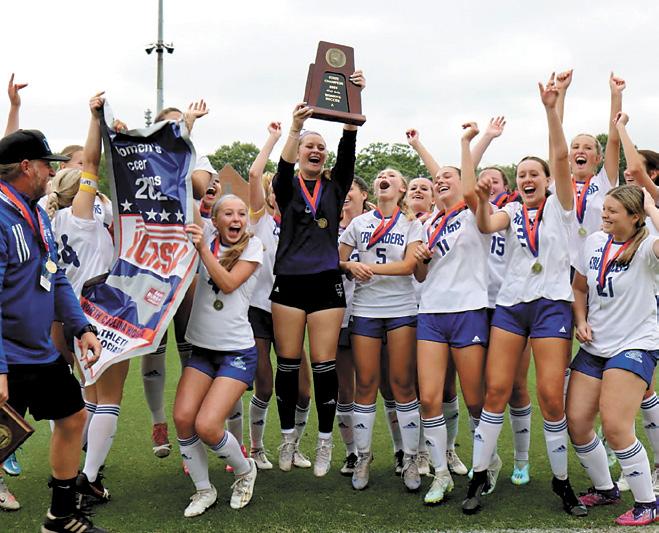
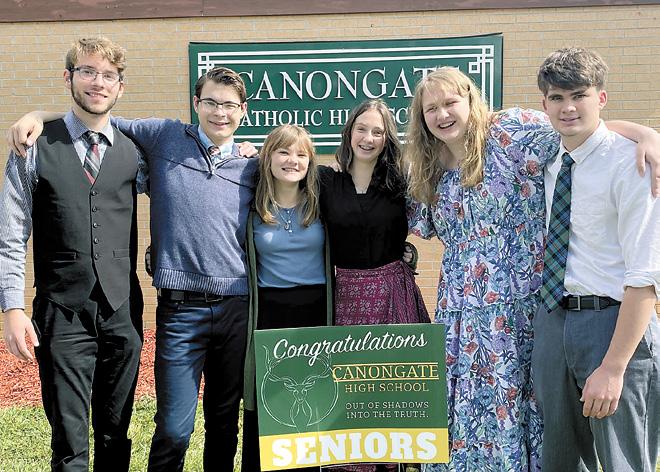

Blakely Sophia Ahmuty
Chrisbel Adriana Alcantara Varela
Luke McKie Andress
David Andrew Armstrong
Nicholas Thomas Arnold
Owen James Aufrance
Nicolas Simon Averill
Camille Rose Barth
Oliver James Bennett
James Earl Bland, III
Maria Denise Boland
Annalisa Frances Boyar
Emma Claire Briody
Christopher Fitzgerald Campbell
Nina Cecilia Cancro
Tanner Hayden Cave
Charley Grace Chappell
Tate Elizabeth Chappell
Annalise Taylor Chmil
Hyanggee Cho
Claire Elizabeth Clampett
Isabella Grace Cobb
Ethan Scott Connor
Ainsley Louisa Claire Culbertson
Arrington Hugh St. John Culbertson
Michael Vincent Raphael D’Ambrosio
Kaitlyn Lianne Deal
Allison Jean Dennen
Mikayla Ann Ebel
Lance Robert Farley
Ella Kathleen Foley
Samantha Sue Foresman
Aniela Jane Giarmo
Kemina Lee Gilstrap
Jackson Elias Goins
Michael Nicolas Perez Golamco
Maria fe Grados Mejia
Jack Thomas Grady
Jamison Markell Graves
Teresa Annette Graves
James Collin Greene
Justine Anne Grimsley
Gannon Charles Grunwald
Enrique Christopher Guzman Cieza
Timothy Michael Hackman
Youliana Yonas Hadgu
Riggs Jackson Handy
Joshua Jason Hanflink
Grace Elizabeth Harriman
Alyssa Gabrielle Harris
Jeanna Lynne Hauk
Katelyn Laura Hawley
Grant Andrew Heilmann
Olivia Angela Henn
Anna Catherine Hoeing
George Wilkinson Hough
Davis Whalen Hunter
John Steele Hutchison
James Barber Jernigan
Axel Juarez
Christopher Taylor Kelly
Anna Sophia Krawczyk
The University of Alabama
American University
Appalachian State University
Assumption University
Auburn University
Averett University
Belmont Abbey College
Brigham Young University-Idaho
Butler University
Campbell University
Cape Fear Community College
Capital University

Catawba College
The Catholic University of America
College of Charleston
Chowan University
Clemson University
Coastal Carolina University
University of Colorado Boulder
Colorado State University-Fort Collins
Commonwealth University - Bloomsburg, Lock Haven and Mansfield
Creighton University
Davidson College
University of Delaware
Denison University
University of Denver
DePaul University
Duke University
Duquesne University
East Carolina University
Eckerd College
Elon University
Florida Atlantic University
Florida Gulf Coast University
Florida State University University of Florida
Fordham University
Furman University
George Mason University
Georgia Institute of Technology-Main Campus
Georgia State University
University of Georgia
Greensboro College
Guilford College
Guilford Technical Community College
Hampden-Sydney College
Hampton University
University of Hawaii at Hilo
University of Hawaii at Manoa
Hawaii Pacific University
High Point University
Howard University
James Madison University
Johnson & Wales University-Charlotte
University of Kentucky
Lebanon Valley College
Lees-McRae College
Lenoir-Rhyne University
Limestone University
Lincoln Memorial University
Louisiana State University
University of Louisiana at Lafayette
University of Louisville
Loyola Marymount University
Loyola University Chicago
Loyola University Maryland
University of Maine
Marshall University
University of Mary Washington
Mary Grace Lipscomb
Laken Cole Locklear
Sandra Rose Lopez
Gianna Madeline Lucido
Matthew Brandon Ma
Avery Claire Mann
Kyra Nicole Marty
Thomas Vincent Mattox
Logan Jason Millard
Blake William Miller
Sarah Elizabeth Mims
Eliza Wynne Ofsanko
Robert Immel-Ahn O’Hale
Catherine Elisha Ouellette
Carter Lawrence Pape
Sofia Pardino
Gracey Lee Payne
Myles Dexter Payne
Jennifer Theresa Peters
Samuel Benjamin Phillips
Bridget Anne Gallagher Plouff
Ryan Mark Porter
Mary Ashton Rainosek
Mary Clare Rashford
Jacob Thomas Regitz
Michael John Riek
Isabella Elaine Ritorto
Isabella Marie Ross
Christopher Ethan Rozek
Merritt Hunt Saffer
Harper Benton Satterfield
University of Maryland-College Park
Marymount University
Mercer University
Meredith College
Michigan State University
Michigan Technological University
Mississippi State University
University of Mississippi
University of Missouri-Columbia
The University of Montana
University of Nebraska-Lincoln
North Carolina A & T State University
University of North Carolina at Asheville
The University of North Carolina at Chapel Hill
University of North Carolina at Charlotte
University of North Carolina at Greensboro
University of North Carolina at Pembroke
University of North Carolina Wilmington
North Carolina State University at Raleigh
Northeastern University
University of Notre Dame
Ohio University-Main Campus
Old Dominion University
Oregon State University
Palm Beach Atlantic University

Pennsylvania State University-Penn State Main
Campus
University of Pittsburgh-Pittsburgh Campus
Providence College
Purdue University-Main Campus
Queens University of Charlotte
University of Rhode Island
University of Richmond
Roanoke College
University of Rochester
Harrison James Satterfield
Andrew Patrick Schrage
Anthony Douglas Schultheis
Ellena Patrice Seeber
Nicholas Michael Seidle
Nadia Evva Slanker
Alexander Bolling Smith
Kendall Joy Smith
Richard Dominic Smith
Stephen Rhodes Smith
Michaela Diane Staudinger
William Michael Stoffel
Grace Caroline Strader
Giuseppe Peter Strafaci
Benjamin Guild Strott
Allston Julius Stubbs, V
Evan McKee Sturgill
Julia Nicole Sullivan
Gianna Victoria Testa
Giang Tran
Anthony Alvin Vignoli
Ryan Alexander Voisard
Caroline Elizabeth Wasilauskas
Connor James Whalen
Sofia Milena Wolff
Charles Thomas Wolschon
Reece Matthew Workman
Huan Yang
Luke Stephen Zakrzewski
Zichen Zhang
Saint Joseph’s University
Saint Louis University
Saint Mary’s College
Saint Mary’s College of California
Salve Regina University
University of San Diego
Santa Clara University
Seton Hall University (College of Arts & Science)
The University of the South (Sewanee)
Simmons University
University of South Carolina-Columbia
University of South Florida-Main Campus
St. John’s University-New York
Stetson University
The University of Tampa
Temple University
The University of Tennessee-Knoxville
Texas Christian University

Ohio State University-Main Campus
Union College (NY)
University of Lynchburg
University of Oregon
Villanova University

Virginia Tech
Virginia Wesleyan University
Wake Forest University
Washington College
Washington State University
Western Carolina University
William & Mary
Wingate University
Wofford College
University of Wyoming
Xavier University
This year’s senior class was awarded more than $12 million in scholarships.
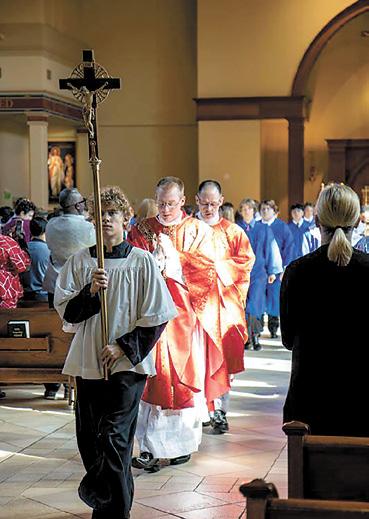
The Diocese of Charlotte’s three high schools celebrated the 496 graduates in the Class of 2023 with special Baccalaureate Masses before their graduations last week.
Christ the King High School’s Baccalaureate Mass was offered at St. Mark Church in Huntersville May 22, celebrated by Christ the King’s chaplain, Father John Putnam, and Father Aaron Huber.
Father Huber reminded the school’s 83 graduates in his homily that as they are scattered throughout the world when they leave Christ the King, they take with them the mission to share Jesus’ message with others and are armed with the gifts of the Holy Spirit in fulfilling that mission.
“How many commencements have you heard in which everyone talks about how they’re going to go out and tackle the universe and take charge and climb and pursue and conquer?” Father Huber asked the students.
“You can. You can do that. But there’s only one way to truly conquer – with the Holy Spirit. The spirit of fortitude, counsel, piety, fear of the Lord, wisdom, understanding and knowledge.
“This Spirit is the one that Christ the King Catholic High School has been at the service of. It’s been the mission of Christ the King to create crusaders so that you can go out into the four corners of the world, and you won’t have to be alone.
“You too can be conquerors, but not on your own. And you will have peace in Christ the King because Christ is with the Father, and we will have peace in Him because He has sent us His Holy Spirit.”
In Charlotte, beaming faces filled St. Matthew Church May 23, as 290 graduates of Charlotte Catholic High
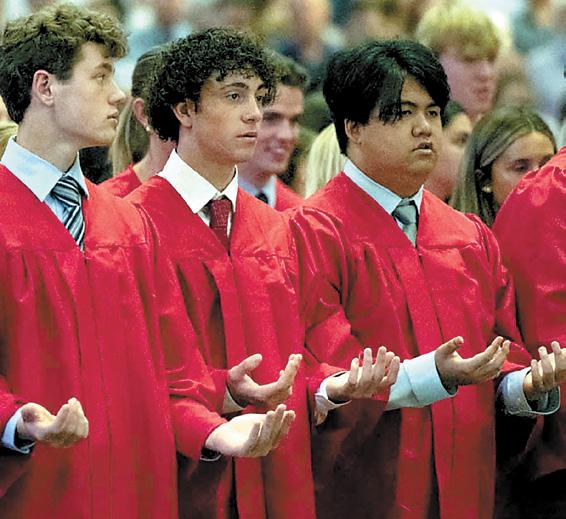
School’s Class of 2023 came to celebrate and give thanks to God.
The church was filled nearly to capacity with graduates in their trademark red gowns – all smiles with their family, friends and teachers around them for the traditional baccalaureate Mass.
During the Mass Father Timothy Reid, the diocese’s vicar of education for Catholic schools, encouraged the graduates to take the life lessons they learned at Charlotte Catholic and use them to become effective witnesses of Christ as they go out into the world. College, work, their lives ahead – adulthood means making choices about what kind of person you want to be, Father Reid said in his homily. “What kind of person are you going to be? Are you going to live your Catholic faith with fidelity?”
“As you go out into the world, don’t lose your Catholic faith,” he told them. “We want you, graduates, to go out into the world and to excel and to be the very best that you can be. But as Christians, we know that we should go out into the world and excel not for our own glory, but for the glory of God and in service to our fellow human beings.”
Holy Cross Church in Kernersville was similarly filled May 25 with 123 joyful graduates of Bishop McGuinness High School, as they gathered for their special Baccalaureate Mass with family and friends.
Father Noah Carter – the school’s chaplain and pastor of the Kernersville parish – celebrated the Mass with local clergy, including Father Jacob Mlakar, parochial vicar, and Deacon Mark Mejias, both of Holy Cross. Dr. Greg Monroe, the superintendent of Catholic schools, was also in attendance to celebrate the occasion.
In his homily, Father Carter reminded the congregation of the school’s motto: “Praesis ut Prosis” or “Excel to Serve.”
“Something can never really be truly excellent unless it’s joined to the Body of Christ,” he said.
Continuing, he explained that after the Son ascended to the Father in heaven, they together pour out the light of the Holy Spirit on the Church to aid its servants in building up the kingdom.
“Many of you have been along this journey together, some of you just at Bishop McGuinness and some of you might have even gone to school together since kindergarten, all for different lengths of time, but now you will go out to diverse places,” Father Carter said.
He connected this moment in graduates’ lives to the Gospel reading, which included the Parable of the Talents.
“That’s the whole point of our Gospel. The master has a different number of talents for a different number of servants. The ones he rewards in return have gone out and grown what God has given them,” Father Carter said. “They have been excellent servants, so the master rewards them.”
In Father Carter’s closing words, he added, “May the Holy Spirit being poured out in your heart by the grace of God in this Mass make you bold and courageous to move forward.
“May you never forget that God walks beside you and Christ in front of you leading you to the heavenly kingdom, but don’t wait! Build that kingdom up each day of your lives.”
As “Ave Maria” played, the students gave their mothers a rose during the Baccalaureate Mass, a meaningful school tradition.
— Spencer K.M. Brown, Catholic News Herald
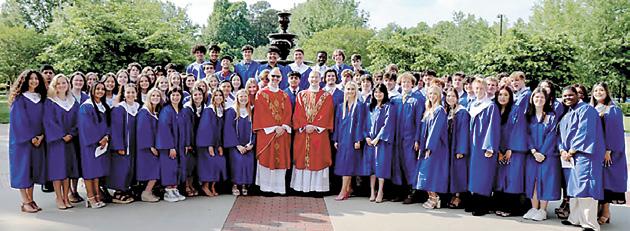
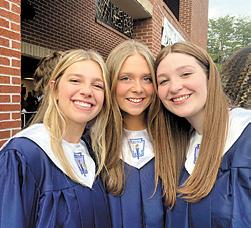
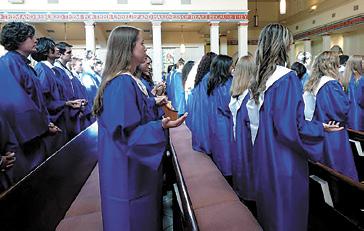
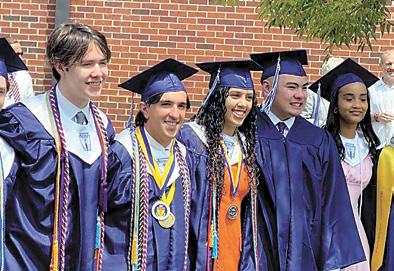
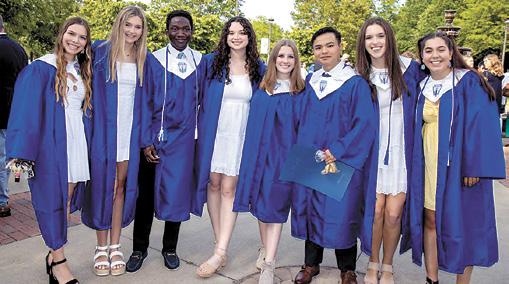


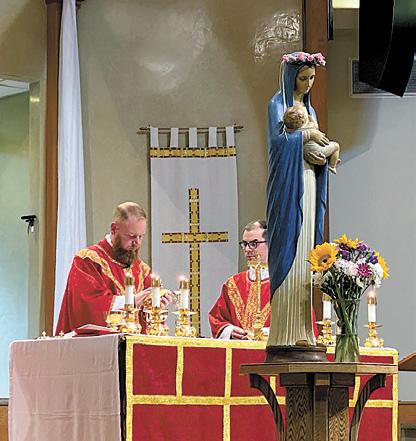
SALISBURY — Sacred Heart Catholic School is a singular place that inspires students to pen beautiful prose encapsulating their time on Lumen Christie Lane in Salisbury, where they have been nurtured in faith, academics, sports, arts and more. As the school year was winding down, Principal Erin Brinkley, an alumna of the school and the winner of the school’s first PTO scholarship essay contest in 2000, took the time to share with the Catholic News Herald three student essays, one written by a 2023 middle school graduate and two by high school senior alumni for this year’s contest.
SACRED
Adam Ebright, a recent graduate of Sacred Heart School, wrote the following essay for Catholic Schools Week. His words stirred the hearts of the pastor and Mass-goers alike as he read it to the congregation earlier this year:

If Jesus is powerful enough to conquer death, what stops Him from destroying us and all sinners? The question may be something to wonder, but most of the time Jesus makes the answer obvious to us. The most Sacred Heart of Jesus and His love for us is what stops Him from taking everyone that hurt Him out of existence. This love and care is wonderful, and is the same embrace I get attending Sacred Heart Catholic School.
To me, Sacred Heart is not only a school for education and learning, it is a place with right and just standards, a place of great spiritual and virtuous growth. Nonetheless, the education is high quality and captivating, and projects lead me to practice other virtues. My freedom and human dignity are supported overall, considering they are the basic principles of human life. With the school and church helping me academically and spiritually, I have almost nothing to worry about when making my Confirmation this year. This school is the absolute embodiment of its name, Sacred Heart. From my time being here, I was able to meet new people and step out of my comfort zone for the first time ever several years back. The still, warm embrace, like Jesus, invites all to partake in this wonderful school that has given me everything I need. This love and comfort help me make it through day by day. Thank you, God bless, and go, Dolphins.
Kyna Lisette Cortez Zaldivar won the 2023 PTO scholarship essay contest at Sacred Heart. She earned $1,000 to use toward her studies at the University of North Carolina at Chapel Hill and was chosen based on her essay, interview and student resume, which includes grades, service and other awards. In her essay, she tells the story of reluctantly transferring to Sacred Heart as a second-grader. In this excerpt, she explains what a gift it turned out to be: Why do I call Sacred Heart “The Perfect Beginning” and “The Perfect Ending”? It was the perfect beginning for my journey of becoming the best student I can be and spiritually the best person I can be.
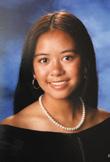
I was introduced to the Sacraments, the Mysteries of the Rosary, and many other Catholic necessities through religion classes. Weekly school Mass allowed me to sit among my peers and listen to readings and homilies which applied to our daily lives as students and children of God. Being surrounded by a community of people who encouraged me to pray and worship allowed me to openly express my faith with no fear. It was the perfect ending to my life in elementary and middle school because of all the lessons I learned. With each lesson’s help, the cycle I mentioned before continues.
Sacred Heart was the ending of a specific time in my life but the start of a new beginning. Throughout my high school years, the lessons Sacred Heart has given me have stuck through working with coworkers at Romano’s Italian restaurant, speaking in front of the Salisbury Rotary Club
without fear, and playing an 80-minute match of soccer at Salisbury High School with vigor and love for the game, and so much more.
I can now confidently say that even though my secondgrade self did not know why I came to Sacred Heart, I know that God brought me here to find that new beginning, where the friendships I make and the values I learn would allow for my success in not only my academic endeavors but also in the world as a whole.
Angelina Pierson also wrote a poignant essay for the PTO scholarship contest. She will attend the University of North Carolina at Wilmington. In her essay, she illustrates how prayer and her Catholic education helped her persevere through the culture shock and anxiety she experienced in high school after graduating from Sacred Heart, where she had found “individuality, spirituality, and growth” in a “faith-driven and cultivated community.” Here is an excerpt that shows just how far she has come:
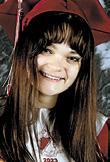
Having spent half of my life surrounded by familiar faces granted me an understanding of the true value of community. The relationships that I hold dearest to me are direct results of Sacred Heart. I was fortunate to be enclosed with friends who I could share my love of God with and build a connection so strong that I consider them family.
I like to believe that my heart comes from Sacred Heart. It comes from the love that the lunch staff put into our meals. It comes from the love of the teachers who drive us toward success. It comes from the encouragement of my friends. It comes from the warm hugs Mrs. Goodman gave me when I was sad.
At Sacred Heart, love was all around me. It has shaped me into the person I am today. I see myself as a person who looks for the colors in a black-and-white world – as someone who searches for kindness in the hearts around me. I find it easy to build relationships and friendships with people because of my experience at Sacred Heart. I can relay my learnings in new settings and create bonds with loving individuals which flourish from a sense of confidence that I never knew existed. Love was a major component of my chapters at Sacred Heart and was something so unique and beautiful that you could not find anywhere else.
KERNERSVILLE — On May 19, Bishop McGuinness High School revived a school tradition by holding a Junior Ring Ceremony following its end-of-year Mass, both presided over by Father Noah Carter, the school chaplain. Each junior class member received a ring engraved with the school seal and motto “Praesis ut Prosis,” which means “Excel to Serve.” The rings represent the students’ membership in the school community and the new leadership role they will assume as seniors.
“I hope you remember the people that you experience this moment with, what the ring on your finger signifies, and your connection to all Bishop alumni going forward,” Julie Gehling, director of counseling, told the students. The students turned their rings around their fingers 24 times to signify their entry into the year of their graduation. In
future years, school leaders hope students will select someone special to present their rings, whether it is a member of the school’s alumni or a parent.
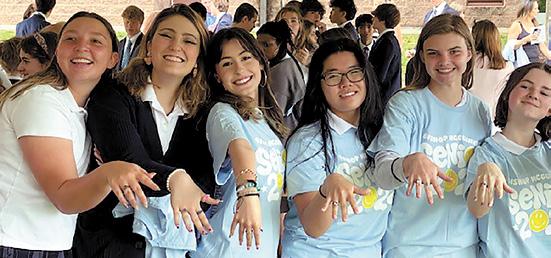
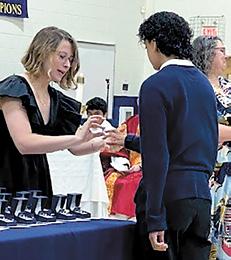
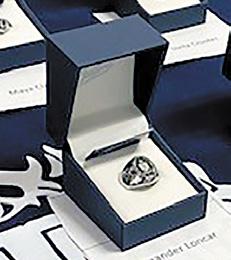
“The goal of these rings is that they will be a symbol of the community that our students belong to at Bishop McGuinness once they’re alumni,” said Katie Williams, the school’s advancement director. “The rings commemorate their hard work and commitment to faith as well as the revival of this school tradition at Bishop.”
The first ceremony of this kind at Bishop McGuinness was held in the chapel of the school’s former campus on Link Road in Winston-Salem in 1984 with Father Francis T. Cancro presiding. — Annie Ferguson
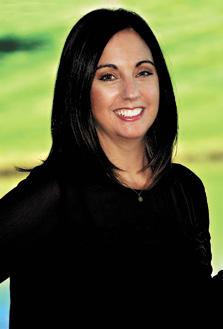
CHARLOTTE — The top brass turned out at Our Lady of the Assumption School May 24 – and the students were ready.
It was time to cut the ribbon on a new $325,000 SmartLab filled with robots and drones, computers and iPads, 3D printers and a laser engraver.

These are learning tools educators could not have imagined a generation ago, part of a hands-on learning approach that teaches critical thinking, problem-solving and collaboration.
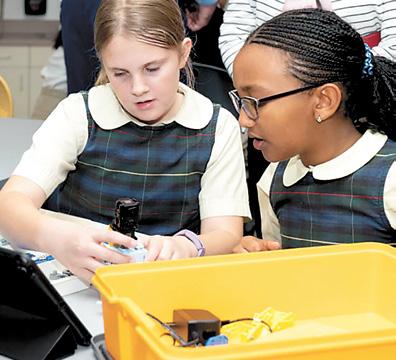
But before two eighth-graders could wield a giant pair of scissors to cut the red ribbon, the entire school – 180 students, prekindergarten through eighth grade – put on a show to welcome diocesan leaders May 24. Among them were Father Timothy Reid, vicar of education for Catholic Schools, and Dr. Greg Monroe, superintendent.
TV news turned out, too!
Standing at the lectern, in a gym adorned with multinational flags to illustrate his students’ diversity, Our Lady of Assumption Principal Tyler Kulp emceed the show.
“What types of things will we learn in the SmartLab?” he asked the students.
“Circuitry!” the pre-kindergartners called out.
“Robotics!” kindergartners shouted.
“Mechanics!” yelled the first-graders.
“Environmental technology… manufacturing technology…software engineering…media arts…recording data… control technology…scientific analysis,” students in each grade called out in turn. Soon it was time to visit the main attraction.
The SmartLab is one of a handful across North Carolina, paid for through federal COVID-19 relief funds.
It’s a classroom with four “learning islands,” each equipped with three computers where two kids are assigned to work together on a project or problem. There are supplies of all kinds to help kids create. They’ll visit the SmartLab twice a week and follow a curriculum designed to take them through all the disciplines.
First-year teacher James Moore says in this classroom he will assist, not lecture. “My job,” he says, “is to direct and guide without giving them the answers. We want the kids to solve problems, to explore and figure it out on their own.”
At one learning island, prekindergartners Daniel and Cassidy used magic markers to draw lines thick enough for a golf ball-sized robot named “Ozobot” to follow on a sheet of paper. This was an intro to “coding.”
At another island, middle schoolers Anthony and Senai followed a computer model to build a bridge out of Lego-like composites.
Then there were eighth-graders John and Delila, who were working on a computer they said to “improve the design” of a flagpole holder their teacher produced on a 3D printer but didn’t work.
“This is very different learning than you do in a traditional class,” Leigh Robertson of SmartLab supplier Creative Learning Systems told students. “The problems you run into – it’s your job to solve those problems. It’s all on you. And you can do a lot of things you didn’t know you could do.”
Eighth-grader John Nguyen was inspired: “Man, I love this lab. There is so much to do and so much to experience. I want to be an engineer mainly because of
this! I get to do this for a job!”
Even their principal couldn’t contain himself: “I can program this thing to follow me around the school,” Kulp said, holding a basketball-size robot on wheels.
Diocesan leaders congratulated the east Charlotte school for its example to others in the diocesan system of 20 schools.
“Catholic schools have always been on the forefront of cutting-edge educational teaching,” Monroe said.
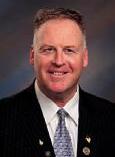

“The more we learn about ourselves and our world, the closer we get to God.”
Father Reid, too, noted the kids’ great blessing and teased that they are “guinea pigs” trying out the SmartLab. “What a great blessing it is to have a SmartLab,” he told students. “It is your responsibility to take it very seriously and use it to the best of its potential and yours.”
University of Alabama
Evan Collins
Andrew Gadams
Olivia Midura
Sydney Sanders
John Shallal
Gabriella Weaver
Appalachian State University
Bryan Anderson
Rachel Andrysick
Grant Bennett
Bailey Centanni
Arianna Deese
Lucia DeNichilo
Jackson Dorsch
Caroline Duffy
Margaret Frantz
Michael Giroux
Olivia Gordon
Jonathan Helms
Avery Kafka
Thomas Little
John Macuga
Kendall McCarthy
Aleksander McIntosh
Connor McMinn
Ellen Michaels
Riley Minor
Rian Mofu
Cate Nguyen
Lee Pederson
Jonathan Riggsbee
David Rios
Mira Scharr
Madelynn Sternberg
Benjamin Thomas
Zachariah Vigre
Mark Zwieback III
Arizona State University
Jack Shea
Auburn University
John Brasser
Owen Dougherty
Elizabeth Freeman
Frederick Kaufmann
Catherine Norton
Summer Sescila
Reagan Stein
Dillon Thailer
Jenna Thompson
Payton Wildman
Baylor University
Katherine Dann
Beacon College
Emylia Hitchell
Belmont Abbey College
Leah Albritton
Hannah Blaha
Mary Katherine Burke
Belmont University
Shaye Foley
Timothy Honey
Benedict College
Aniyah Scales
Campbell University
Ian Grier II
Carnegie Mellon University
Steven Shea
Catawba College
Ian Pierce
Catholic University of America
Clare Polking
Central Piedmont Community College
Kiara Campos
Ariadna Diaz
Charles Hagen
Maya McGowan
Jaden Petras
Richard Scola
Liam Thomas
Clemson University
Laura Anderson
Declan Bridges
Tyler Dorsey
Liam Foley
Myers Gaston
Ashleigh Gonsalves
Catelyn Griffith
Hailey Guella
Matthew Hallsten
Malia Hileman
Joseph Martinsen
Riley McClatchy
Charles McLaurin, Jr.
Christopher Moniz-Johnson
John-Luke Nosacka
Andrew Painter
Macey Petho
Anabella Riera
Coastal Carolina University
Brandon Alford
George Duross
Charles Foster
Colgate University
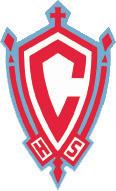

Nathan Molloy
College of Charleston
Aidan Clifton
Katherine Redican
Ella Sixbury
University of Colorado Boulder
Alexandra Brigham
Columbia College Chicago
Charles Gory
Connecticut College
Megan Pons
Dartmouth College
Martin Tivnan, Jr.
Davidson College
Ana Palomino
University of Dayton
Benjamin Lennon
Andrew Woeste
University of Delaware
Molly Baumgratz
Denison University
Clara Bumgarner
DePaul University
Emma Weeks
Duke University
Meredith Beatty
Kara Bivens
Catherine Ramich
East Carolina University
Emery Anderson
Sydney Bowman
Eckerd College
Amber Ruland
EF Gap Year Pathfinder Program
Ronan Kerrigan
Elon University
Samuel Cudjoe
Jacob Rogers
Flagler College
Barbara Tucker
University of Florida
Kayla Maher
Florida International University
Isabella Terral
Florida State University
Davis Clawson
Ethan Ellis
Quinnton Lombardo
Alexandra Shevsky
Fordham University
Meredith Bush
Chloe Lefaivre
Furman University
Alexander Kedar
Gap Year Colin Chalmers
George Mason University
Sarah Dichak
Caroline Rodriguez
George Washington University
Eva Kelleher
Georgetown University
Abigail Hahn
University of Georgia
Clinton Barlow
Jane McArdle
Gettysburg College
Owen McAllister
Hampden-Sydney College
Marcus Lemmond
Hampton University
Olivia Roberson
High Point University
Madison Danser
Immaculata University
Aidan Payton
Madelyn Seay
Indiana University Bloomington
Thomas Hicks
Jacksonville University
Hayden Garnett
James Madison University
Emily Hernandez
Jillian Kelley
Johnson & Wales University
Zoë Eugene
Joao Paulo Valente Da Silva Santos
Kansas State University
Kate van Kesteren
University of Kentucky
Cara Grasso
Willie Kim
Alma Medina
Grace Quinlan
Djuan Scott
Kutztown University of Pennsylvania
Patrick Maher
Liberty University
Skyler Neuenschwander
Louisiana State University
Bailey Fontenot
Loyola University Maryland
Jack Parmley
University of Lynchburg
Ryan Bambrick
Marist College
Delia Hahn
Miami University
Emily Carano
Max Stein
Michigan State University
Henry Cusack
University of Mississippi
Chase Fuller
Peyton Gilchrist
Luke Johnson
Jackson Lanier
Samantha Lloyd
Mary Russell
Thomas Williams
Montreat College
Zechariah Turner
New England Conservatory of Music
Genie Alvarado
North Carolina State University
Christian Coto Sanchez
Frederick Fisher
Jackson Fitzpatrick
Anna McNulty
Kaleb Thorpe
University of North Carolina at Asheville
Julien Javillonar
Jake Young
University of North Carolina at Chapel Hill
Isabella Abril-De Nicola
Zoe Duncan
Ava Elaasar
Hannah Grzeskiewicz
Cecilia Ha
Andrew Heiser
Joseph Hickman
Patrick Keese
Philippe Lefaivre
Anna Ludwiczak
Emily Lutgring
Kamryn Maichle
Campbell McClellan
Domenico McPhillips
Lauren Miller
Alexander Montaño
Mary Morgan
Isabella Nalitz
Kevin O’Brien
Maryanne O’Brien
Christopher Poveromo, Jr.
Sophia Sarrantonio
Margaret Schilli
Madalyn Schmitz
Glenn Sedam IV
James Tillman
Savannah Veit
University of North Carolina at Charlotte
Angelo Alexander
Javier Guarisma
Joseph Keough
Rooney Le
Jonathan Mathis
Bryan Navarrete
Ava Nicoletti
Bo Wilson
University of North Carolina at Greensboro
Lillian Kuhn
Trevor Zeleznik
University of North Carolina
Wilmington
Breanna Banik
Viviana Correa
Kaitlyn Dobur
Conor Maguire
Annmarie Mullen
Ashley Sofarelli
Katherine Tronco
Northwestern University
Laura Horne
University of Notre Dame
Gabriela Chamorro
Michael Egan
Pace University
Justice Upshaw
Piedmont University
Frangey Medina
Presbyterian College
Jacob Deller
Princeton University
Edward Kernodle
Purdue University
William Ferguson
Sara Sams
Leyla Sleime
Queens University of Charlotte
Aaliyah Bernal
Monserrath Gonzalez Alpizar
Nicholas Potter
Mery Tinoco
University of Rochester
Roman Farra
Saint Francis University
Evan Chromy
San Diego State University
Ashley Clawson
Anna Oltmanns
Santa Barbara City College
Parker Wooton
Savannah College of Art and
Design
Michael Guthrie
Alyssa Kaczmarski
Ava Lefaivre
Gavin van Rensburg
University of South Carolina
Kylee Baisley
William Bergren
Emma Blanton
Joseph Rotola
Ian De Jesus-Trieu
Katherine Hammonds
Audrey Lobdell
Georgia Stewart
Samuel Truong
University of South Carolina
Lancaster Davis Russell
University of Tennessee
Ellie Baumgratz
Hailey Brtalik
Joshua Cockinos
Jackson Hancock
Luke Jensen
Nicholas Keiger
Rowan Mahoney
Jacob Reichert
Kaci Sento
Griffin Sovine
Michael Spicer
Vaughn Thomas
Tess Valkovschi
Texas Christian University
Morgan Hernandez
Elliot Johnston
Hunter McNamara
Parker Scott
US Army
John Pulgarin
US Marine Corp
Matthew Saele
Villanova University
Valentina Suarez-Esquetini
Virginia Polytechnic Institute and State University
Gavin Banks
Lauren Brockmann
Christian McCarty
Elisabeth McFee
Crawford Thornton
Wake Technical Community
College
Riley Wooton
West Virginia University
Sean Boyle
Western Carolina University
Denzel Cox
Abbe Hannon
Gavin Hood
Alexander Kirol
Jackson Rouse
Simon Schrift
Abbey Willis
College of William & Mary
Julia Gehrig
Wingate University
Cristal Tshunza
Winthrop University
Cameron Daigle
University of Wisconsin
Erica Hession
Wofford College
Elizabeth Ham
Shannon Ryan
Elizabeth Stephenson
Worcester Polytechnic Institute
Joseph Baisley
Xavier University
John Lind
Evan Tesch
The Senior Class of 2023 has earned a total of $26,466,756 in scholarships. We congratulate these seniors, as well as the entire senior class, for their many outstanding accomplishments.
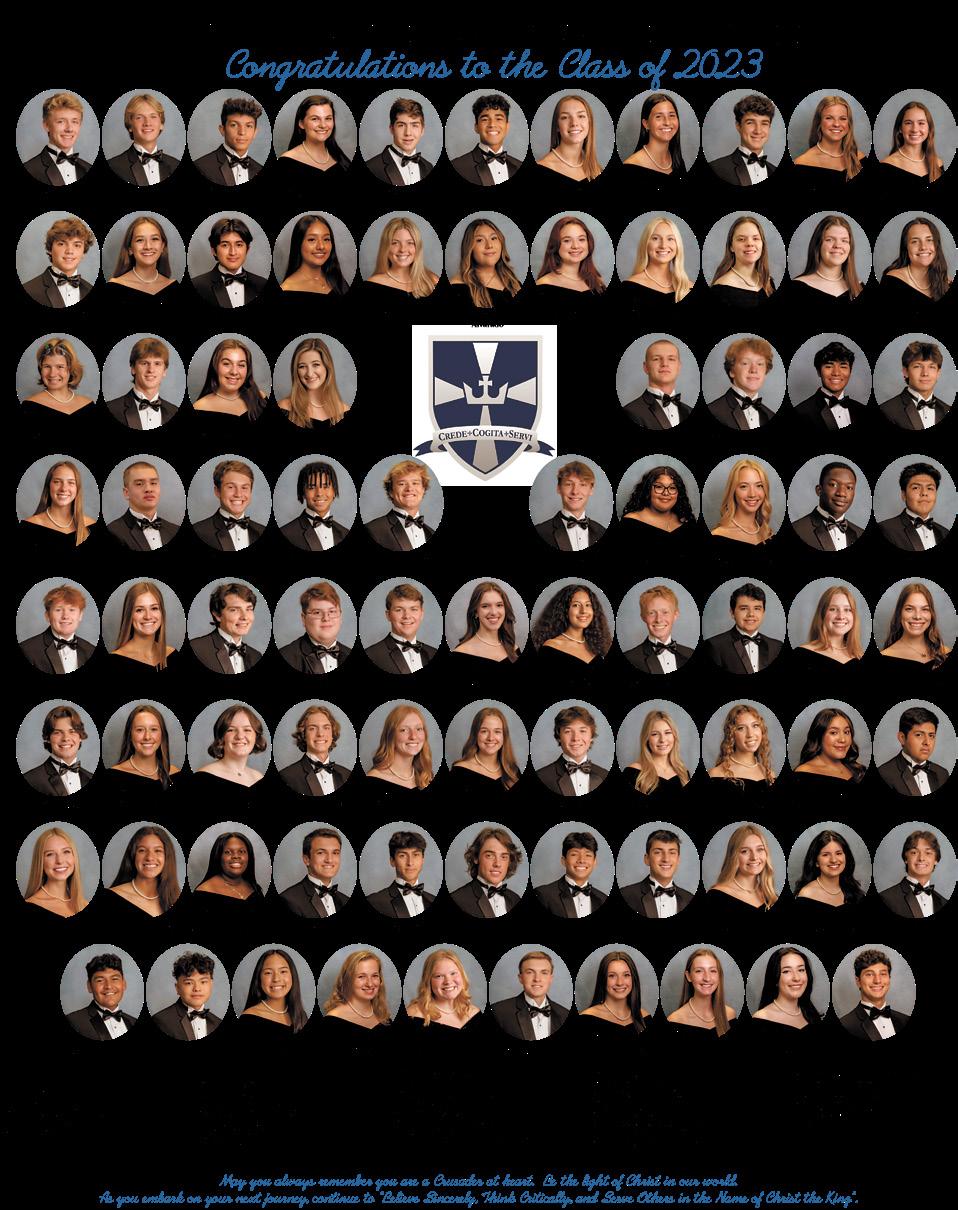
HUNTERSVILLE — Like the “seven reputable men” the apostles searched for in the Book of Acts, seven men from the Diocese of Charlotte were found worthy to be ordained deacons June 3 at St. Mark Church in Huntersville.
More than 1,000 friends, family and clergy members gathered for the ordination presided over by Archbishop Gregory J. Hartmayer, OFM Conv., of the Archdiocese of Atlanta.


The archbishop presided at the ordination Mass at the request of Bishop Peter Jugis, who has been experiencing health issues that kept him from attending.
At the start of the ordination rite, the seven men were called to stand before Archbishop Hartmayer at the steps of the altar and Father Christopher Gober, diocesan vocations director, attested to their preparedness for holy orders.

During the two-hour Mass, Archbishop Hartmayer delivered a homily directed toward the seven men, explaining the various parts of the ordination rite and giving them advice as they begin serving God and the
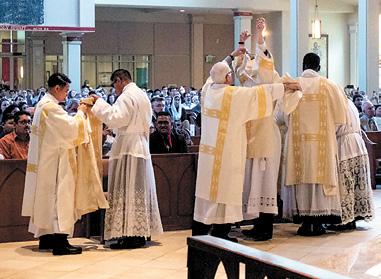
One step closer to the priesthood,
Church as ordained ministers, emphasizing their role as servants.
“When you are ordained a priest, you don’t eliminate the diaconate from your experience, we add to it so that the directive and the mission to serve is always with you. It will always be yours as a priest as well, as a bishop as well,” he said.
During the ordination rite, the men arose and, one by one, approached the archbishop. He laid hands on each man’s head and prayed the prayer of ordination over them, thus consecrating them as deacons.
In his homily, the archbishop told the new deacons that the laying on of hands and the prayer of consecration “sets you apart as deacons. The prayer reminds us that the diaconal ministry is one of service and preaching. Those two words, however important and meaningful, do not capture completely the great task God has called you to. True greatness is found in service.”
Archbishop Hartmayer continued, “When you serve at the table of the Eucharistic feast, there you will find the presence of Jesus, who gives Himself to you, so you can give yourselves to others. It must begin here, at the altar. It
The men then lay prostrate before the altar as the congregation prayed the Litany of the Saints.
The newly vested deacons again approached the sanctuary one by one, receiving the Book of the Gospels from Archbishop Hartmayer and an acknowledgment from him, welcoming them to their new role in the Church.
The seven deacons will now be able to proclaim the Gospel at Mass, preach at the invitation of the priest, prepare the altar for the sacrifice of the Eucharist, distribute the Lord’s Body and Blood to the faithful, administer baptisms, officiate at marriages, bring Viaticum to the dying, conduct funeral rites, instruct believers and nonbelievers in Church doctrine, preside over public prayer and perform works of charity.
The newly ordained deacons are Matthew Wayne Dimock Jr., Christian Joseph Goduti, Matthew Philip Harrison II, Kevin Ruben Martinez, José Alfredo Palma Torres, Elliott Cade Suttle and Kevin Michael Tran.
“It really is a joyful moment,” said newly ordained Deacon Suttle. “But the part that hit me the most really was the Kiss of Peace with the other deacons and with
After all the candidates were ordained, they put on a deacon’s vestments – a stole across one shoulder and then a dalmatic (the outer robe a deacon wears at liturgies) – thanks to help from assisting deacons or priests they personally chose to vest them. Each of the new deacons share who vested them at Saturday’s Mass, and why:
n Matthew Dimock Jr.: Deacon Peter Rusciolelli — “Deacon Rusciolelli and I have been in seminary together since we both entered in 2016, and he has proven to be a good friend. He will be ordained a priest a couple weeks after my ordination to the diaconate. I look forward to serving the people of our diocese with him next year, when, Lord willing, I am also ordained a priest.”
n Christian Goduti: Deacon Christopher Brock — “I look up to him as a brother seminarian and would be honored to be vested by him.”
n Matthew Harrison II: Deacon Martin Ricart III — “He has been a good example to me of a Deacon who lives out his vocation with joy.”
is
priesthood,
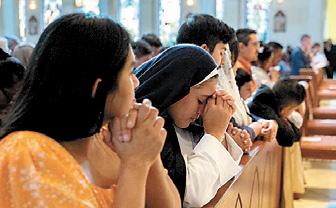


the archbishop himself. You could really feel the love the archbishop had for us even though we’re not part of his archdiocese. And all the deacons were just super happy that we’re part of their order now. It is joining a brotherhood, a spiritual brotherhood. And you can really feel that connection with them.”
Deacon Jim Mazur, who ministers at Sacred Heart Parish in Salisbury, said, “The new deacons seem like very good, devout, holy men, and I think they’re going to make great priests. It is a life of sacrifice and a life of prayer, but there’s no greater reward than to serve God.”
Father Christopher Geiger, the vice rector and director of formation at Mount St. Mary’s Seminary & School of Theology in Cincinnati, Ohio, where the new deacons have been studying, also praised the efforts of the young men.
“They are an incredible group of guys. They have just been wonderful,” he said. “Charlotte is very lucky to have these men as deacons now, but certainly, in a year, they’re going to do great,
great work. We’re very excited to see how the Lord works through them. They’re good men, and we look forward to hearing about all the good they will do in years to come.”
The men are considered “transitional” deacons as compared to “permanent” deacons – a reflection that they intend to serve a year in pastoral, liturgical and educational preparation before they are considered for ordination to the priesthood in 2024. Deacons are the first of three types of holy orders; the other two are priest and bishop.
In comments after Mass, Monsignor Patrick Winslow, vicar general and chancellor of the Charlotte diocese, thanked Archbishop Hartmayer for presiding at the Mass, and noted that next year, God willing, the diocese will ordain the seven men as priests. “We look forward to next year,” he said with a smile.
Archbishop Hartmayer also thanked the parents of the new deacons and said it was a joy to ordain their sons.
“You haven’t lost your sons. You’ve gained all
of these,” he said, motioning toward the deacons and priests in attendance. “They’re all yours, too. So, (set) a couple of extra places at the table. You won’t even notice,” he joked. He continued, “I want to underscore how important you as parents and family and friends have been to these young men’s lives all throughout their formation. They have received from you encouragement, prayers, a listening ear. You’ve been with them, you’ve walked with them, you’ve accompanied them. So they are now, in the eyes of the Church, prepared to serve.”
At www.catholicnewsherald.com : See video highlights, Archbishop Hartmayer’s complete homily and many more photos from the ordination Mass.
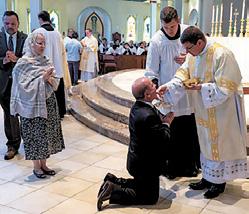
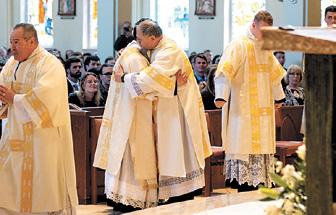
n Kevin Martinez: Deacon Mark Mejias of Holy Cross Parish in Kernersville. “He is a great person, and I am pretty fond of him. He has also set an excellent example for me of how a deacon should serve in the Church.”
n José Palma Torres: Deacon Van Tran — “I became good friends with Deacon Van Tran during my Theology years, and I wanted to be vested by one of my classmates.”
n Elliott Suttle: Deacon William Shaw — “The Shaw family sort of adopted me shortly after I moved to Greensboro and have become my Catholic family.”
n Kevin Tran: Deacon Chinonso Nnebe-Agumadu — “We have known each other and have been discerning with each other since our days in Catholic Campus Ministry. (He attended North Carolina A&T.) Having him vest me seemed like a fitting conclusion to our days of formation together.”
— Kimberly BenderHUNTERSVILLE — Al igual que los “siete hombres de buena reputación” que los apóstoles buscaron para instituir la oficina del diaconato, según relata el Libro de los Hechos de los Apóstoles, siete hombres de la Diócesis de Charlotte fueron encontrados dignos para este cargo y fueron ordenados diáconos el 3 de junio en la Iglesia San Marcos en Huntersville.
Más de 1,000 amigos, familiares y miembros del clero se reunieron para la ordenación presidida por el Arzobispo Gregory J. Hartmayer, OFM Conv., de la Arquidiócesis de Atlanta.
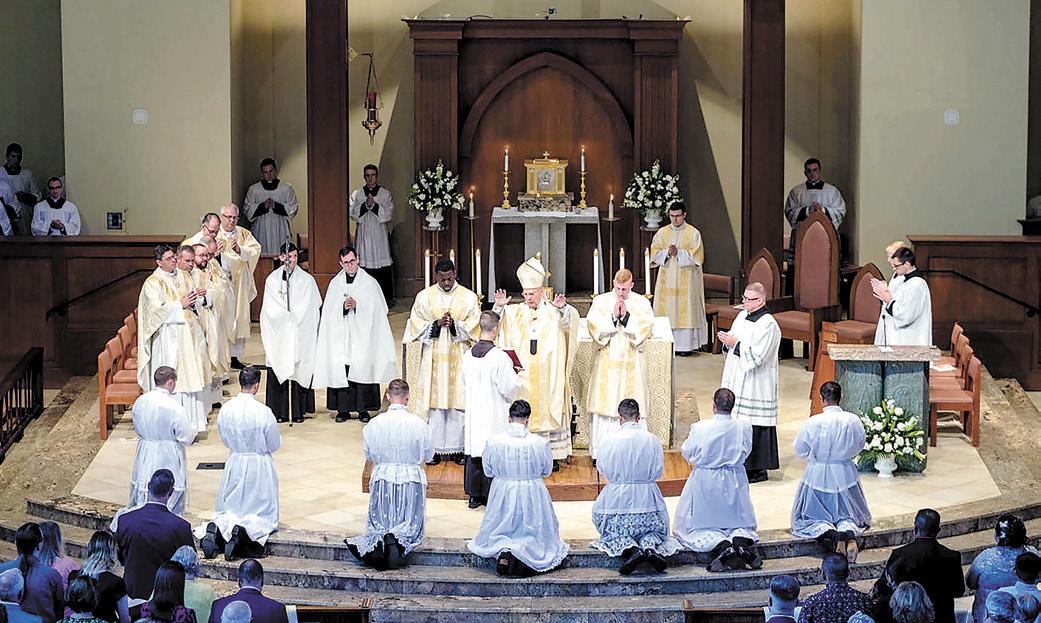
El arzobispo presidió la Misa de ordenación a pedido del Obispo Peter Jugis, quien ha estado experimentando problemas de salud que le impidieron asistir.
Al inicio del rito de ordenación, los siete hombres, que servirán en la Diócesis de Charlotte, fueron llamados a presentarse ante el Arzobispo Hartmayer en los escalones del altar, y el Padre Christopher Gober, director diocesano de vocaciones, dio fe de su preparación para las órdenes sagradas.
Durante la Misa de dos horas, el Arzobispo Hartmayer
pronunció una homilía dirigida a los siete hombres, explicando las diversas partes del rito de ordenación y dándoles consejos para su inicio en el servicio a Dios y a la Iglesia como ministros ordenados, enfatizando su papel como siervos.
“Cuando eres ordenado sacerdote, no eliminas el diaconado de tu experiencia. Lo agregamos para que la directiva y misión de servir estén siempre contigo. Siempre será tuyo como sacerdote, y como obispo también”, dijo. Durante el rito, los hombres se levantaron y, uno por uno, se acercaron al arzobispo. Él impuso sus manos sobre la cabeza de cada hombre y rezó la oración de ordenación sobre ellos, consagrándolos así como diáconos.
En su homilía, el arzobispo dijo a los nuevos diáconos que la imposición de manos y la oración de consagración “los distingue como diáconos. La oración nos recuerda que el ministerio diaconal es de servicio y predicación. Esas dos palabras, por importantes y significativas que sean, no captan completamente la gran tarea a la que Dios los ha llamado. La verdadera grandeza se encuentra en el servicio”.
El Arzobispo Hartmayer continuó, “cuando sirvan en la mesa de la fiesta eucarística, allí encontrarán la presencia de Jesús, que se entrega a ustedes para que puedan
entregarse a los demás. Debe comenzar aquí, en el altar. Es Cristo lo que das a los demás”.
Luego, los hombres se postraron ante el altar mientras la congregación rezaba la Letanía de los Santos.
Los diáconos recién investidos se acercaron nuevamente al altar uno a uno, recibiendo el Libro de los Evangelios de manos del Arzobispo Hartmayer, así como el reconocimiento y bienvenida a su nuevo papel en la Iglesia.
Los siete diáconos ahora podrán proclamar el Evangelio en la Misa, predicar por invitación del sacerdote, preparar el altar para el sacrificio de la Eucaristía, distribuir el Cuerpo y la Sangre del Señor a los fieles, administrar bautismos, oficiar matrimonios, llevar el Viático a los moribundos, realizar ritos funerarios, instruir a creyentes y no creyentes en la doctrina de la Iglesia, presidir la oración pública y realizar obras de caridad.
Los diáconos recién ordenados son Matthew Wayne Dimock Jr., Christian Joseph Goduti, Matthew Philip Harrison II, Kevin Rubén Martínez, José Alfredo Palma Torres, Elliott Cade Suttle y Kevin Michael Tran.
“Realmente es un momento de alegría”, dijo el recién ordenado diácono Suttle. “El momento que más me impactó fue el Beso de la Paz con los otros diáconos y con el propio arzobispo. Realmente
El diácono Goduti prepara el altar para la Sagrada Comunión.
Después que todos los candidatos fueron ordenados, se pusieron una estola de diácono y una dalmática con la ayuda de los diáconos o sacerdotes que personalmente eligieron para ello. Cada uno de los nuevos diáconos comparte quién los invistió en la misa del sábado y por qué:
n Matthew Dimock Jr.: Diácono Peter Rusciolelli. “El Diácono Rusciolelli y yo hemos estado juntos en el seminario desde que ambos ingresamos en 2016, y él ha demostrado ser un buen amigo. Será ordenado sacerdote un par de semanas después de mi ordenación diaconal. Espero servir a la gente de nuestra diócesis con él el próximo año, cuando, si Dios quiere, también yo sea ordenado sacerdote”.

n Christian Goduti: Diácono Christopher Brock. “Lo admiro como un hermano seminarista y me he sentido honrado de ser investido por él”.
n Matthew Harrison II: Diácono Martin Ricart III. “Para mí, él ha sido un buen ejemplo de un diácono que vive su vocación con alegría”.
n Kevin Martínez: Diácono Mark Mejías de la Parroquia Holy Cross en Kernersville. “Es una gran persona y le tengo mucho cariño. También me ha dado un excelente ejemplo de cómo un diácono debe servir en la Iglesia”.

n José Palma Torres: Diácono Van Tran. “Me hice buen amigo del Diácono Van Tran durante mis años de Teología, y quería ser investido por uno de mis compañeros de clase”.
n Elliott Suttle: Diácono William Shaw. “La familia Shaw me adoptó poco después de mudarme a Greensboro y se ha convertido en mi familia católica”.
que el arzobispo tenía por nosotros, a pesar de que no somos parte de su arquidiócesis. Y todos los diáconos estaban súper felices de que ahora seamos parte de su orden. Es unirse a una hermandad, una hermandad espiritual. Y realmente puedes sentir esa conexión con ellos”.
El Diácono Jim Mazur, que sirve en la parroquia Sagrado Corazón en Salisbury, dijo que, “los nuevos diáconos parecen hombres muy buenos, devotos y santos, y creo que van a ser grandes sacerdotes. Es una vida de sacrificio y una vida de oración, pero no hay mayor recompensa que servir a Dios”.
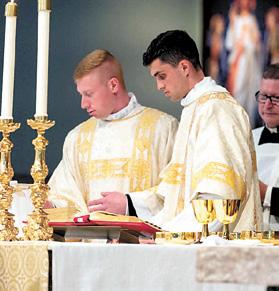
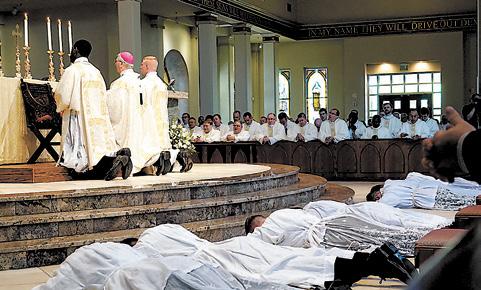
El Padre Christopher Geiger, vicerrector y director de formación en Mount St. Mary’s Seminary & School of Theology, donde los nuevos diáconos han estudiado, también elogió el esfuerzo de los jóvenes.
“Son un grupo increíble de jóvenes. Simplemente han sido maravillosos”, dijo. “Charlotte es muy afortunada de tener a estos hombres como diáconos ahora, pero ciertamente, en un año, van a hacer un gran,
gran trabajo. Estamos muy emocionados de ver cómo el Señor obra a través de ellos. Son buenos hombres, y esperamos escuchar todo el bien que harán en los próximos años”.
Los hombres son considerados diáconos “de transición”, en comparación con los diáconos “permanentes”, una reflexión de que tienen la intención de servir un año en preparación pastoral, litúrgica y educativa antes de ser considerados para la ordenación al sacerdocio en 2024. El diaconado es el primero de tres tipos de órdenes sagradas; los otros dos son sacerdote y obispo.

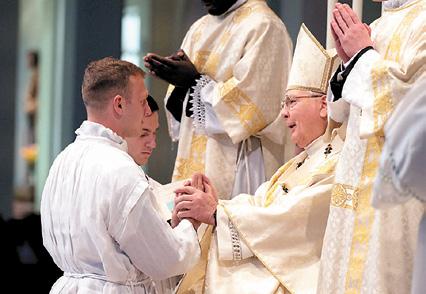
En comentarios después de la Misa, Monseñor Patrick Winslow, vicario general y canciller de la diócesis de Charlotte, agradeció al Arzobispo Hartmayer por presidir la Misa, y señaló que el próximo año, si Dios quiere, la diócesis ordenará a los siete hombres como sacerdotes. “Lo esperamos con ansias”, dijo sonriente.
El Arzobispo Hartmayer también agradeció a los padres de los nuevos diáconos y les dijo que era una alegría ordenar a sus hijos.
“No han perdido a sus hijos. Ustedes se han ganado a todos ellos”, dijo, señalando a los diáconos y sacerdotes presentes. “Todos son suyos también. Entonces, (pongan) un par de lugares adicionales en la mesa. Ni siquiera se darán cuenta”, bromeó. Luego continuó, “quiero subrayar lo importante que han sido ustedes, como padres, familiares y amigos, para la vida de estos jóvenes a lo largo de su formación. Han recibido su aliento, sus oraciones, un oído atento. Han estado con ellos, han caminado con ellos, los han acompañado. Así que ahora, a los ojos de la Iglesia, están preparados para servir”.
Más online
En www.catholicnewsherald.com encontrará más información, videos y galerías de fotos sobre la ordenación al diaconado de los siete seminaristas de la Diócesis de Charlotte.
n Kevin Tran: Diácono Chinonso Nnebe-Agumadu. “Nos hemos conocido y hemos estado discerniendo el uno con el otro desde nuestros días en el Ministerio Universitario Católico. (Asistió a North Carolina A&T.) Que me vistiera me pareció un término adecuado para nuestros días de formación juntos”.
En el pasado mes de mayo revivimos con mucha alegría el sentimiento mariano, la devoción a la Virgen, Madre de Dios, y el culto de veneración que le rendimos los cristianos católicos.
Por ser el mes de la Virgen la sentimos muy cercana y deseamos hacer muchas cosas para agradarla, darle gracias por su trabajo intercesor y pedirle nos alcance las gracias y bendiciones que proceden de Dios.
Fue un mes para el rezo del Santo Rosario, recordar las apariciones en Cova de Iría, encuentros, retiros, consagraciones y renovaciones de las mismas, procesiones y, lo más grande, la Eucaristía.
Fue un mes para vivir en familia este ambiente de oración y prácticas religiosas en honor de la Virgen, en la que los niños aprenden la devoción a María, viendo y oyendo a sus padres rezar el Santo Rosario, arreglar el altar a la Virgen, ir a la Iglesia, a la Eucaristía, y participar activamente de las procesiones.
Sabemos que los niños aprenden viendo y oyendo, y qué mejor que ver y oír a sus papás. Los padres les muestran las imágenes y las estampas de ella, los invitan a ponerlas en el altarcito que tiene en casa, a buscar las flores y a iluminarlo. Es una escuela para el aprendizaje mariano.
La Misión del Santo Rosario hunde sus raíces en esta escuela. Son muchas las familias, padres, madres, hijos y familiares los que han aprendido en ella, y muchos la traemos desde nuestras tierras, casas, ranchos, fincas, aldeas, pueblos y ciudades.
En la Misión encuentran esas enseñanzas y los medios para fortalecerlas y practicarlas con otras familias dentro de la comunidad parroquial, vicarial y diocesana, sin aficiones, fanatismos, reparos o dobles sentidos.
Entramos en la dimensión de la verdadera devoción a la Madre de Dios y las prácticas que la fortalecen, lo mismo que de la Consagración a su Inmaculado Corazón para llegar al Sagrado Corazón de su Hijo, Jesús el Señor. Los Misioneros del Santo Rosario celebraron como cierre del mes de la Virgen un retiro en la parroquia Nuestra Señora de los Ángeles en Marion, en el que revivieron esta verdadera devoción en compañía de hermanos llegados de diferentes parroquias (Kannápolis, Concord, Newton, Hickory, Boonville, Lenoir).
Muchos renovaron su consagración y también nuevas familias se consagraron. Fue una jornada asistida por el párroco, el padre Carl y el Diácono Darío, junto con los equipos de la Misión de cada parroquia, jóvenes y niños. Los compromisos adquiridos por los consagrados son asistir frecuentemente a la Eucaristía, a la confesión periódica, tener presentes las promesas bautismales, rezar diariamente el Santo Rosario, honrar a la Virgen, en especial, en los meses de mayo y octubre, buscar familias para prepararlas para consagración, animar a los consagrados a renovarla, asistir a la reunión y al cenáculo mensualmente.
La mayoría de las actividades deben vivirse en familia. Muchos consagrados dan testimonio de como se crece en la fe animados por la devoción a la santísima Virgen en el seno del hogar, camino para llegar a Jesús.
¡A Jesús por María!
DIÁCONO DARÍO GARCÍA es diácono y coordinador del ministerio hispano del vicariato de Hickory.
CÉSAR HURTADO rchurtado@charlottediocese.org
CHARLOTTE — Seguramente tiene algún amigo, amiga o familiar que ha asistido a un encuentro Emaús y constantemente lo invita a que participe en uno de ellos. Si no es así, habrá visto fotografías en las que aparecen decenas de grupos de damas y caballeros, por separado, sonriendo felices mientras comparten uno de estos encuentros.
La pregunta se cae de madura. ¿Qué tienen de especial estos retiros que todo mundo parece pasarla muy bien, concluyen la jornada de tres días muy contentos, salen dispuestos a cambiar el mundo y, en muchos casos, cambian su estilo de vida radicalmente para bien?
El Padre Julio Domínguez, vicario episcopal del ministerio Hispano de la Diócesis de Charlotte, define a Emaús como un movimiento apostólico de evangelización de llamado, sobre todo en las periferias, para incorporarse o retornar a la experiencia de la Iglesia Católica.
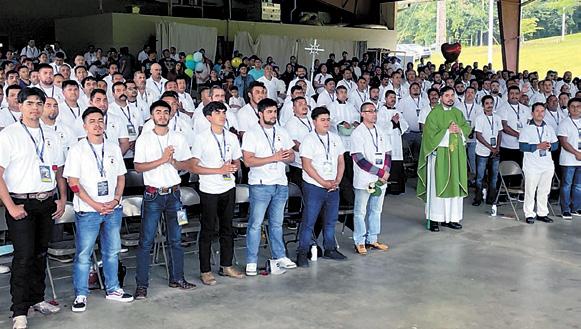
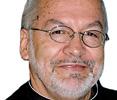
“La función del retiro, de acercar a las personas a Dios, está basado en el Evangelio de San Lucas (Lucas 24:1335) cuando Jesús sale al encuentro de los que estaban perdidos, los encuentra, camina con ellos explicándoles las escrituras. Sus discípulos luego lo reconocen cuando parte el pan. Ahí estamos hablando de la Eucaristía, de la Adoración Eucarística, del encuentro del Cristo que murió, pero resucitó”, explica el P. Domínguez.
INICIOS
Hace más de 30 años, Myrna Gallagher, evangelizadora incansable al servicio de la parroquia San Luis en Miami, Florida, bajo la supervisión de su párroco y con el consentimiento de su obispo, creó un retiro para que la gente pudiera acercarse a Dios, reconocerlo, experimentar su amor y conocer que realmente ‘Jesucristo ha resucitado’ y es un Dios vivo.
El éxito fue inmediato y se extendió con rapidez a otras parroquias, ciudades en Estados Unidos, Europa, Latinoamérica e incluso, se dice que de manera clandestina, a China.

En abril de 2007 se llevó a cabo el primer retiro en Las Carolinas, en idioma inglés, en la parroquia San Philip Neri, en Rock Hill.
En 2010, contando con la aceptación del entonces párroco de la Iglesia San Gabriel en Charlotte, Padre Frank O’Rourke, se realizó un retiro en español bajo la coordinación de Domingo Roger, quien había participado en un encuentro en Miami.
(Izquierda) Decenas de hombres, participantes de un encuentro de la Familia Emaús, aparecen junto al Padre Julio Domínguez.
(Abajo) La parroquia Nuestra Señora de Guadalupe da la bienvenida a las mujeres que participaron del último retiro Emaús que organizaron.
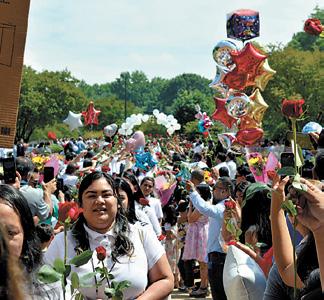
Hace aproximadamente once años, después de participar en un encuentro Emaús en Charleston, Carolina del Sur, el Padre Domínguez creó ‘La Familia Emaús’, una adaptación del retiro original.
“Ahí me presentaron un retiro muy bonito que, a mí como sacerdote, me tocó mucho”, dice, pero debido a creyó conveniente realizar algunos cambios, los representantes en Miami le pidieron que no utilizara el nombre original, por lo que decidió nombrarlo como ‘La Familia Emaús’.
“Se realiza lo esencial del retiro, pero se cambian algunas cosas en razón a las diferentes realidades que se viven en Florida, en relación con Carolina del Norte”, explica el Padre Domínguez, quien también es director espiritual de ese movimiento.
Sin embargo, paralelamente al movimiento fundado por el Padre Domínguez, coexisten otros grupos de Emaús que desarrollan actividades en parroquias como Nuestra Señora de Guadalupe en Charlotte, San Miguel en Gastonia, San Gabriel en Charlotte y muchas más, a los que el P. Domínguez apoya incondicionalmente.
El Avivamiento Nacional Eucaristico es una iniciativa trascendental, de tres años de duración, que dará frutos en los años venideros. Durante el anterior Año de Avivamiento Diocesano, el clero y los líderes diocesanos construyeron los cimientos para que este movimiento prosperara a nivel parroquial.
Este año, a partir de la Fiesta del Corpus Christi el 11 de junio de 2023, cada parroquia responderá a cuatro invitaciones claves.
1) A revigorizar el culto.
La belleza de la liturgia eleva la mente y el corazón de los asistentes a la Misa, ayudándoles a armonizar su disposición interior con el exterior de lo que se celebra.
2) A fomentar el encuentro personal con Jesús en la Eucaristía.
Se nos invita a crear espacios, nuevas oportunidades en nuestras parroquias, al menos mensualmente, para que la gente de
Más online
En www.es.eucharisticrevival.org : Encuentre más información, recursos, sugerencias y actividades para este año de avivamiento eucarístico.

nuestras parroquias se encuentre cara a cara con el Dios vivo, Jesús en la Eucaristía.
3) A promover una formación sólida en la fe.
La mayoría de los católicos que van a Misa no entienden o no aceptan la doctrina de la Presencia Real. Este año, estamos invitados a cambiar esta situación proporcionando una sólida formación en torno a esta asombrosa realidad. La Conferencia de Obispos
Católicos de Estados Unidos (USCCB), nos pide que organicemos ciclos de predicación e iniciativas de grupos pequeños en los que Jesús y la Eucaristía sean el tema central.
4) A enviar misioneros. Se nos pide que movilicemos a los católicos en que están cómodamente sentados en las bancas, como espectadores. Cada feligrés será invitado a llegar al menos a una persona con el mensaje del amor eucarístico de Cristo. Es importante estar motivado para invitar a un amigo o familiar a volver a la Misa, así como también acompañar al necesitado y marginado.
La USCCB nos recuerda con amor una frase de Santa Teresa de Calcuta: “¿Qué convertirá a América y salvará al mundo? Mi respuesta es la oración. Lo que necesitamos es que cada parroquia se presente ante Jesús Sacramentado en Horas Santas de oración”.
— National Eucharistic Revival
SPENCER K.M. BROWN skmbrown@charlottediocese.org
CHARLOTTE — Los Diáconos Christopher Brock, Chinonso NnebeAgumadu y Peter Rusciolelli serán ordenados sacerdotes el 17 de junio en la Iglesia San Marcos en Huntersville por el Atlanta Arzobispo Gregory Hartmayer, OFM Conv.
En medio de una preocupación de salud en curso, el Obispo Peter Jugis anunció el 1 de junio que no oficiará las liturgias de ordenación de la Diócesis de Charlotte, las que están siendo celebradas por el arzobispo.
El Obispo Jugis dijo que ha estado enfrentando un “problema de salud” y que las pruebas médicas revelaron recientemente que solo tiene un riñón en funcionamiento. Su condición, dijo, “no es potencialmente mortal, pero a veces afecta mi capacidad de viajar o participar en largas liturgias y otras ocasiones”.
A petición del obispo, el Arzobispo Hartmayer presidió la ordenación diaconal de siete seminaristas el 3 de junio y también presidirá la ordenación sacerdotal el 17 del mismo mes.
Fue hace poco más de un año que el Obispo Jugis comenzó a experimentar síntomas que le impidieron presidir en algunas ocasiones, incluidas las Misas de ordenación en junio pasado. El Arzobispo Hartmayer asistió presidiendo una de esas liturgias: la ordenación al diaconado de Christopher Brock, Chinonso NnebeAgumadu y Peter Rusciolelli. El Arzobispo Hartmayer ahora regresa para ordenarlos como sacerdotes.
Los tres jóvenes recibieron recientemente su Maestría en Divinidad
EMAÚS
Respecto a la clave del éxito de los encuentros Emaús, el Padre Domínguez opina que “la alegría, un don que particularmente el Espíritu Santo otorga al movimiento, es clave en la integración de los participantes. El amor verdadero que muestran los organizadores a los asistentes y entre ellos mismos hace que se cree una fraternidad cristiana que persiste en el tiempo. Todos nos llamamos hermanos”. La recomendación al término de los
del Seminario y Escuela de Teología Mount St. Mary en Cincinnati, Ohio, el paso académico final en su formación.
A medida que se acerca la ordenación, el Diácono Rusciolelli, cuya parroquia es la Catedral San Patricio en Charlotte, dijo: “Estoy muy emocionado por mi día de ordenación, ya que es algo que he estado anticipando, pensando y orando durante mucho tiempo. Estoy supremamente agradecido por las gracias que Nuestro Señor me ha dado para seguir Su santa voluntad, así como por todos aquellos que me han apoyado de tantas maneras durante estos años”.
Para el Diácono Brock, cuya parroquia es San Vicente de Paúl en Charlotte, hay mucha emoción en los días previos a la ordenación.
“Cuando entré al seminario hace seis años, lo hice porque creía que Dios me estaba llamando a ser sacerdote, por lo que ver mi día de ordenación a la vuelta de la esquina es de mucha alegría y emoción”.
“Estoy nervioso porque esta no es una tarea fácil, pero también emocionado de ver cómo Dios me usará como su sacerdote en la misión de darle gloria y atraer almas a Él”, dijo el Diácono NnebeAgumadu, cuya parroquia es Santo Tomás de Aquino en Charlotte. “A medida que se acerca este gran día, no puedo evitar mirar hacia atrás a la formación que he recibido estos últimos seis años y confiar en que me han preparado bien para la vida que tengo por delante”. Después de su ordenación, los tres servirán como sacerdotes para la Diócesis de Charlotte. Sus primeras asignaciones pastorales serán anunciadas al término de la Misa de ordenación.
Todos son bienvenidos a asistir a la Misa de las 10 de la mañana, el sábado 17 de junio, en la Iglesia San Marcos, 14740 Stumptown Road en Huntersville.
retiros es que los participantes busquen la formación continua en base a la Eucaristía y se integren completamente a la parroquia. “No me gusta que se distingan con camisas, en respeto a los otros movimientos de su parroquia. El demonio ataca con la soberbia. Si nos incorporamos a la parroquia, y esto es válido para todos los movimientos, lo hacemos unidos, sin diferencias de ningún tipo”, dice el P. Domínguez, añadiendo que el servicio a la parroquia debe realizarse sin descuidar a la propia familia. “No podemos ser ‘candil en la calle y oscuridad en hogar’”. Para el P. Miguel Sánchez, vicario de la parroquia San Mateo, quien también participó en un encuentro Emaús, la adoración continua y la oración constante
son esenciales, junto a la sinceridad y entrega de los servidores, pues a los participantes les da la confianza de que, “si Dios pudo ayudar a esta persona a cambiar, lo puede hacer conmigo también”. Resalta que se crea una relación sincera que mucha gente nunca ha experimentado. “Es decir, se siente una hermandad real que te ayuda se ser más abierto a la hora de mirar en tu interior”.
Si desea experimentar un encuentro personal con Jesús resucitado a través de un retiro Emaús o de La Familia Emaús, consulte con el coordinador del ministerio hispano o de ese movimiento apostólico de su parroquia. Ellos podrán encaminar su interés.
CHARLOTTE — Treinta seminaristas de la Diócesis de Charlotte seminarians han sido asignados para colaborar en las parroquias este verano, anunció la Oficina de Vocaciones de la diócesis. El servicio se efectuará desde el sábado 3 de junio hasta el domingo 6 de agosto.
Los seminaristas y sus asignaciones son las siguientes:
n Clement Akerblom: Parroquia San Juan Evangelista en Waynesville
n Christopher Angermeyer: Parroquia Nuestra Señora de Gracia en Greensboro
n Robert Bauman: Parroquia Nuestra Señora de la Merced en Winston-Salem
n Michael Camilleri: Parroquia
San Judas en Sapphire
n John Cuppett: Parroquia
Santa Margarita María en Swannanoa
n Anthony del Cid Lucero: Parroquia Inmaculada Concepción en Hendersonville
n Matthew Dimock Jr.: Parroquia San Marcos en Huntersville
n Kolbe Flood: Parroquia Santa Bernardita en Linville
n Maximilian Frei: Parroquia
San Juan Evangelista en Waynesville
n Christian Goduti: Parroquia
Sagrada Cruz en Kernersville
n Matthew Harrison II: Parroquia San Leo el Grande en Winston-Salem



n Bryan Ilagor: Parroquia
Inmaculada Concepción en Hendersonville
n James Johnson IV: Parroquia
San Gabriel en Charlotte
n Nicholas Kramer: Parroquia
San Juan Bautista en Tryon
n Bradley Loftin: Parroquia San Juan Bautista en Tryon
n Michael Lugo: Parroquia
Santa Bernardita en Linville
n Luke Martin: Parroquia Sagrado Corazón en Salisbury
n Patrick Martin: Parroquia
Reina de los Apóstoles en Belmont
n Emanuel Martinez: Parroquia
Santo Tomás de Aquino en Charlotte
n Kevin Martinez: Parroquia
Santo Tomás de Aquino en Charlotte
n Kolbe Murrey: Parroquia
Santa Ana en Charlotte
n José Palma Torres: Parroquia
Santa Ana en Charlotte
n Elliott Suttle: Parroquia María
Auxiliadora en Shelby
n Andrew Templeton: Parroquia
San Marcos en Huntersville
n Peter Townsend: Parroquia
San Marcos en Huntersville
n Kevin Tran: Parroquia San Miguel Arcángel en Gastonia
n James Tweed: Parroquia San Judas en Sapphire
n Bailey Van Nosdall: Parroquia
San Leo el Grande en WinstonSalem
n Connor White: Parroquia
Sagrada Cruz en Kernersville
n Joseph Yellico: Parroquia
Santa Margarita María en Swannanoa
Se anunciaron las asignaciones de verano para los seminaristas
CÉSAR HURTADO
rchurtado@charlottediocese.org
El domingo 11 de junio se celebra en Estados Unidos la Solemnidad de Corpus Christi, una de las más importantes fiestas litúrgicas católicas, pues recuerda al mundo que Jesucristo está presente de forma viva y real en la Eucaristía.
Tiene sus raíces en la Edad Media y se estableció en el año 1264, cuando el Papa Urbano IV emitió una bula papal llamada “Transiturus de hoc mundo”. Este documento hizo de la festividad de Corpus Christi una celebración universal de la Iglesia católica.
La fiesta se instituyó para honrar y adorar la presencia real de Jesucristo en la Eucaristía. Durante la celebración de la Misa, el pan y el vino se convierten en el cuerpo y la sangre de Cristo. La fiesta enfatiza la importancia de este sacramento y fomenta la devoción hacia la Eucaristía.
Corpus Christi se extendió rápidamente por toda Europa y convirtió en una de las festividades religiosas más importantes del calendario litúrgico. En muchas ciudades y pueblos se llevaron a cabo elaboradas procesiones en las que se exhibía y se adoraba la Eucaristía en una custodia dorada. Durante estas procesiones se decoraban las calles con alfombras de flores y realizaban danzas y representaciones teatrales.
A lo largo de los siglos, la fiesta de Corpus Christi ha evolucionado y adquirido distintas tradiciones y manifestaciones culturales en diferentes regiones del mundo.
En Cusco, Perú, por ejemplo, la fiesta de Corpus Christi adquirió un gran significado debido a la fusión de la religión católica con las tradiciones y la cosmovisión andina, dando lugar a una celebración única y colorida.
En Cusco se combinan elementos de la religión católica introducida por los españoles y las tradiciones ancestrales de los pueblos indígenas de la región. Esta fusión refleja la historia y la interacción cultural entre los conquistadores españoles y la población indígena durante la época colonial.
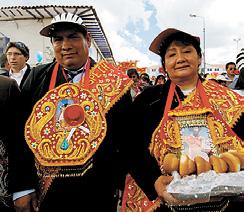
Algunos aspectos destacados de esta mixtura son:
Las procesiones: Durante la procesión de Corpus Christi en Cusco, además de las figuras y símbolos católicos tradicionales, se incluyen también íconos andinos como las imágenes de los santos patronos locales o los apus (espíritus de las montañas).
Las alfombras de flores: Estas coloridas alfombras son elaboradas con pétalos de flores y materiales naturales, y representan una mezcla de símbolos cristianos y andinos, como cruces, figuras de animales sagrados y diseños geométricos.
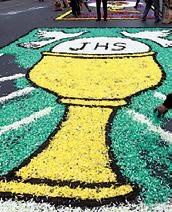
Las danzas y la música: Las danzas
folklóricas tradicionales son una parte integral de la celebración. Durante el Corpus Christi en Cusco, se realizan danzas andinas, como las de los Chunchos y los Negritos, entre otras. Estas danzas están llenas de movimientos vigorosos, coloridos trajes tradicionales y música en vivo con instrumentos como la zampoña, la quena y el tambor.
La fusión andina y católica en la celebración del Corpus Christi en Cusco es una muestra del respeto por la diversidad y nos invita a reflexionar sobre la importancia de valorar y respetar las diferentes tradiciones y cosmovisiones culturales. La combinación de elementos católicos y andinos en la celebración del Corpus Christi en Cusco es un ejemplo de cómo las culturas pueden entrelazarse y enriquecerse mutuamente, permitiendo la coexistencia pacífica de diferentes sistemas de creencias.
JUNIO 11-17
Domingo (Solemnidad de Corpus Christi): Deuteronomio 8:2-3, 14-16, 1 Corintios 10:16-17, Juan 6:51-58; Lunes: 2 Corintios 1:1-7, Mateo 5:1-12; Martes (San Antonio de Padua): 2 Corintios
1:18-22, Mateo 5:13-16; Miércoles: 2 Corintios 3:4-11, Mateo 5:1719; Jueves: 2 Corintios 3:15–4:1, 3-6, Mateo 5:20-26; Viernes (Solemnidad del Sagrado Corazón de Jesús): Deuteronomio
7:6-11, 1 Juan 4:7-16, Mateo 11:25-30; Sábado (Memoria del Corazón Inmaculado de la Bienaventurada Virgen María): 2
Corintios 5:14-21, 30-31, Lucas 2:41-51
Desde arriba a la izquierda en sentido horario: La Catedral del Cusco recibe miles de visitantes durante la procesión. En la procesión Eucarística también participan imágenes de los santos y devociones locales. Las calles por donde pasa la procesión son cubiertas de alfombras de flores multicolores. Los mayordomos, encargados comunales de la organización de la fiesta, llevan una vestimenta representativa de su santo patrón.
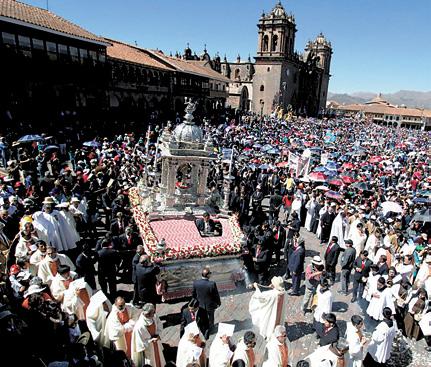

Santo Tomás de Aquino: “La Eucaristía es el sacramento del amor: significa amor, produce amor. La Eucaristía es la consumación de una vida espiritual completa”.
Santa Eufrasia: “Hablar del Sagrado Sacramento es hablar de lo más sagrado. Cuán a menudo, cuando estamos en un estado de angustia, aquellos en quienes buscamos ayuda nos dejan; o lo que es peor, añaden cargas a nuestra aflicción poniendo más problemas sobre nosotros. Él siempre está ahí, esperando para ayudarnos”.
San Juan Crisóstomo: “No es el hombre el responsable de las ofrendas en la medida en que se convierten en el Cuerpo y la Sangre de Cristo; es Cristo mismo quien fue crucificado por nosotros. La figura de pie pertenece al sacerdote que pronuncia estas palabras. El poder y la gracia pertenecen a Dios. “Este es mi cuerpo”, dice. Y
JUNIO 18-24
Domingo: Éxodo 19:2-6a, Romanos 5:6-11, Mateo 9:36-10:8; Lunes (San Romualdo Abad): 2 Corintios 6:1-10, Mateo 5:3842; Martes: 2 Corintios 8:1-9, Mateo 5:43-48; Miércoles (San Luis Gonzaga): 2 Corintios 9:6-11, Mateo 6:1-6, 16-18; Jueves: 2 Corintios 11:1-11, Mateo 6:7-15; Viernes: 2 Corintios11:18, 21-30, Mateo 6:19-23; Sábado (Natividad de San Juan Bautista): Isaías 49:1-6, Hechos 13:22-26, Lucas 1:57-66, 80
estas palabras transforman las ofrendas”.
San Maximiliano Kolbe: “Si los ángeles pudieran estar celosos de los hombres, lo estarían por una razón: la Sagrada Comunión”.
San Pío de Pietrelcina: “Mil años de disfrutar la gloria humana no valen ni siquiera una hora dedicada a una dulce comunión con Jesús en el Santísimo Sacramento”.
San Francisco de Asís: “¡Oh sublime humildad! ¡Oh humilde sublimidad! Que el Señor de todo el universo, Dios e Hijo de Dios, se humille así y se esconda bajo la forma de un poco de pan, para nuestra salvación.”
San Agustín: “Lo que ves es el pan y el cáliz; eso es lo que tus propios ojos te informan. Pero lo que vuestra fe os obliga a aceptar es que el pan es el cuerpo de Cristo, y el cáliz es la sangre de Cristo. Esto se ha dicho muy brevemente, lo que tal vez sea suficiente para la fe; sin embargo, la fe no desea la instrucción”.
— Spencer Brown, editor; ACI Prensa, Catholicnet, EWTN y otros medios católicos colaboraron
JUNIO 25-JULIO 1
Domingo: Jeremías 20:10-13, Romanos 5:12-15, Mateo 10:26-33;
Lunes: Génesis 12:1-9, Mateo 7:1-5; Martes: Génesis 13:2, 5-18, Mateo 7:6, 12-14; Miércoles (San Irineo): Génesis 15:1-12, 17-18, Mateo 7:15-20; Jueves (Solemnidad de San Pedro y San Pablo): Hechos 12:1-11, 2 Timoteo 4:6-8, 17-18, Mateo 8:1-4; Viernes: Génesis 17:1, 9-10, 15-22, Mateo 8:1-4; Sábado (San Junípero
Serra): Génesis 18:1-15, Mateo 8:5-17
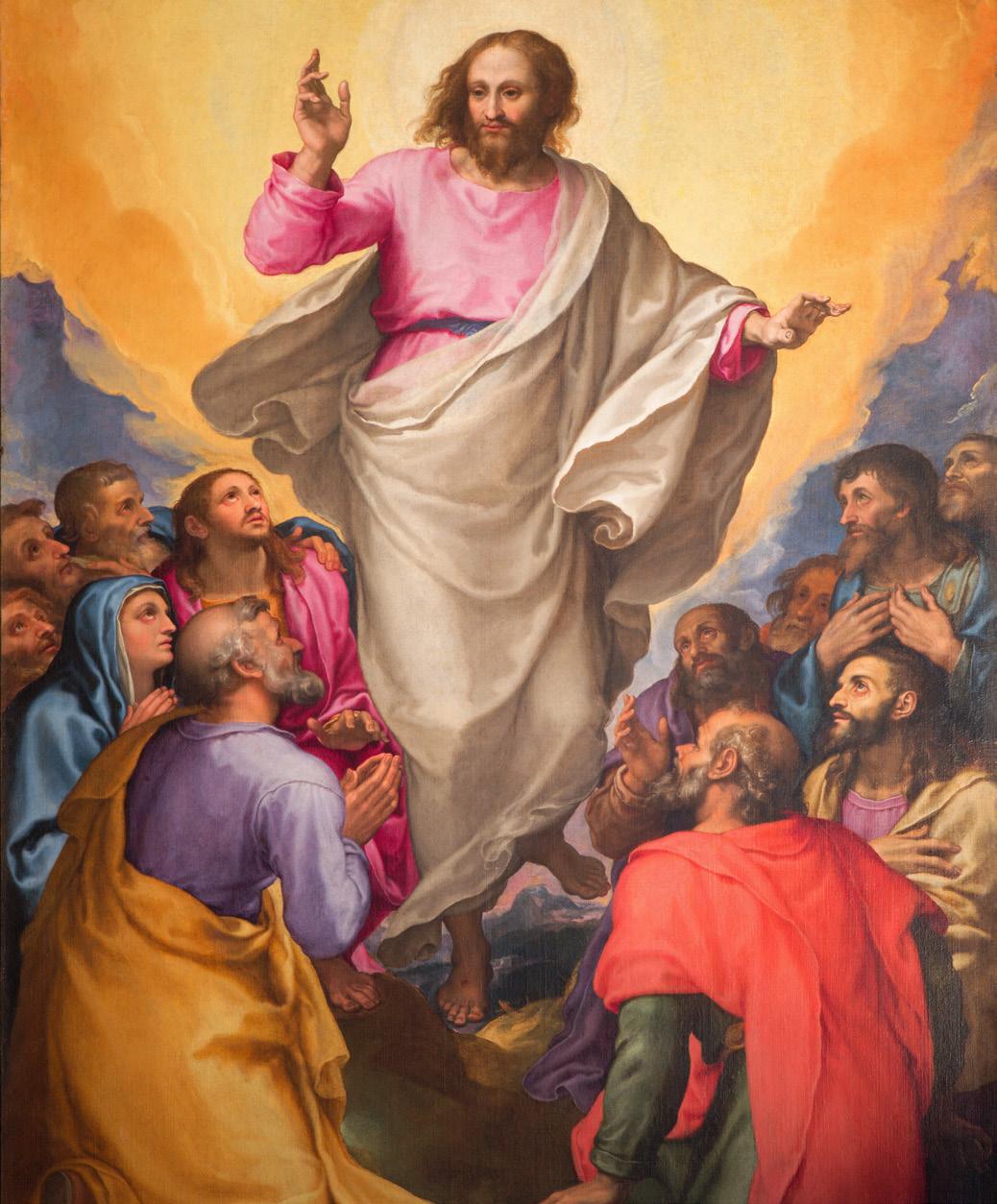
 KIMBERLEY HEATHERINGTON OSV News
KIMBERLEY HEATHERINGTON OSV News
For parents still wondering if social media can be harmful to their children’s mental health, U.S. Surgeon General Dr. Vivek Murthy had a warning May 23: “We are in the middle of a national youth mental health crisis, and I am concerned that social media is an important driver of that crisis – one that we must urgently address.”
The “Surgeon General’s Advisory on Social Media and Youth Mental Health” is 21 pages of details and statistics succinctly summarized in the accompanying U.S. Department of Health and Human Services (HHS) press release: “While social media may offer some benefits, there are ample indicators that social media can also pose a risk of harm to the mental health and wellbeing of children and adolescents.”
Since HHS reports that almost 95% of young people ages 13-17 use social media – with more than one out of three saying they are on social media “almost constantly” – the scope of Murthy’s concern is nearly universal.
“The most common question parents ask me is, ‘is social media safe for my kids’. The answer is that we don’t have enough evidence to say it’s safe, and in fact, there is growing evidence that social media use is associated with harm to young people’s mental health,” Murthy
noted in the same press release. “Children are exposed to harmful content on social media, ranging from violent and sexual content, to bullying and harassment. And for too many children, social media use is compromising their sleep and valuable inperson time with family and friends.”
“Not only does the surgeon general’s report call for something to be done – it calls for something to be done fast,” said Amanda Raffoul, an instructor in the pediatrics department at Harvard Medical School, and a fellow in the division of adolescent and young adult medicine at Boston Children’s Hospital.
The HHS notes that “among the benefits, adolescents report that social media helps them feel more accepted (58%), like they have people who can support them through tough times (67%), like they have a place to show their creative side (71%), and more connected to what’s going on in their friends’ lives (80%).”
Nonetheless, excessive use of social media poses serious consequences, with the HHS observing “recent research shows that adolescents who spend more than three hours per day on social media face double the risk of experiencing poor mental health outcomes, such as symptoms of depression and anxiety; yet one 2021 survey of teenagers found that, on average, they spend 3.5 hours a day on social media. Social media may also perpetuate body dissatisfaction, disordered eating
behaviors, social comparison, and low selfesteem, especially among adolescent girls.”
Almost half (46%) of teens ages 13-17 said social media made them feel worse about their body image. Hate-based social media content also is “often” or “sometimes” encountered by 64% of adolescents.
Jessica Heldman, a child rights professor at the University of San Diego and a member of its Children’s Advocacy Institute, said Big Tech companies must nonetheless be held responsible for the harm done to youth.
“They are learning to starve themselves, harm themselves, and loathe themselves as they replace sleep and healthy activity with hours on social media,” Heldman
said of teen social media users. “Yet, social media platforms continue to profit off of algorithms and design features that push harmful content to children and make it nearly impossible to disengage from their platforms.”
Christopher McKenna, a digital security expert, founder of Protect Young Eyes, noted that “in culture today, we tend to treat children as if they are mini adults. And that is simply untrue. Childhood is unique. The brains of children are unique. They are in a unique developmental phase. We are experimenting on children,” said McKenna. “We can’t wait for science to catch up with the experience that parents and educators are observing firsthand.”
Rev. Sebastian Doris, OSB – 1990
Giving appreciated stock to your parish, Catholic school, agency, the diocese or the Foundation creates a gift that will benefit your desired beneficiary and provide you tax benefits.
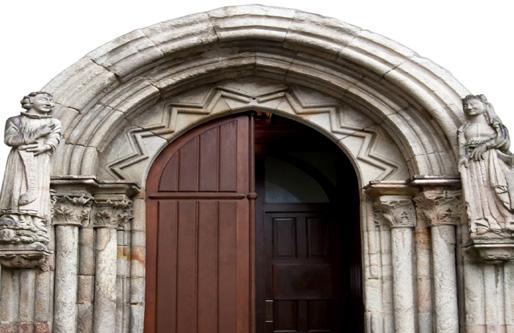
For more information, go to www.charlottediocese.givingplan.net
Rev. Kurt M. Fohn – 2022
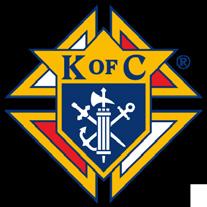
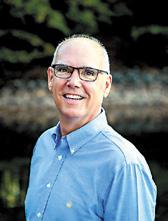
Rev. Guy E. Morse – 2000
Rev. Msgr. Roueche – 2000
Rev. Gabriel Stupasky, OSB - 1974
For the latest news 24/7: catholicnewsherald.com
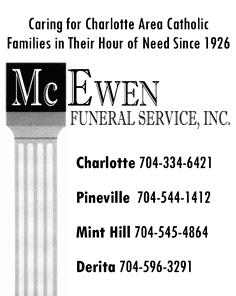

WASHINGTON, D.C. — Prior to the first anniversary of a landmark decision by the Supreme Court to overturn its prior abortion precedent, pro-life activists lauded legislation passed in multiple states while advocating for additional support services for women and families facing unplanned pregnancies. The Supreme Court issued its decision in Dobbs v. Jackson Women’s Health Organization on June
24, 2022, undoing nearly a half-century of its own precedent on abortion as a constitutional right. The case involved a Mississippi law banning abortion after 15 weeks, in which the state directly challenged the high court’s previous abortion-related precedents in Roe v. Wade. Jeanne Mancini, March for Life president, said that the first post-Roe year has been “amazing in so many ways” in reducing abortion, but it also has introduced “an element of confusion.” The way forward, Mancini said, must be to “lean into this and do it with a lot of love” and also “emphasize the truth that prolife is pro-woman, whether it’s the support of a pregnancy care center or funding support at the state level.”
NEW ROCHELLE, N.Y. — Nearly 200 clergy and laypeople gathered on the pleasant
• Are you a current Cursillista looking to continue your 4th Day?
• Would you like to find a local Ultreya?
• Would you like to know more about the Cursillio Movement? Visit us at http://charlottecursillio.com/


grounds of Iona University in New Rochelle for the annual New York Catholic Bible Summit June 3. Following sung liturgy of the hours, Michael Barber, professor of sacred Scripture and theology at the Augustine Institute in Denver, began his presentation on “Old Testament Typology of the Eucharist.” Early in his talk, Barber reminded readers of a common statement about reading the Bible: “When we pray to God, he listens to us; when we read Scripture, we listen to him,” Barber said, quoting St. Augustine. “The Bible is not just what God said; It’s what God says right now, it is his word to us,” he added. “Reading the Bible is a phenomenally powerful way to strengthen a friendship with Jesus,” said Cardinal Timothy M. Dolan of New York, during Mass celebrated at the university’s Hynes Athletic Center. “Nothing comes close to the power of God’s word when proclaimed at the Mass,” Cardinal Dolan said.

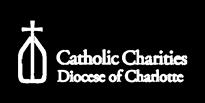
ROME — Devotion to Marian apparitions should lead people to Jesus and not to a particular individual or community, Pope Francis said.
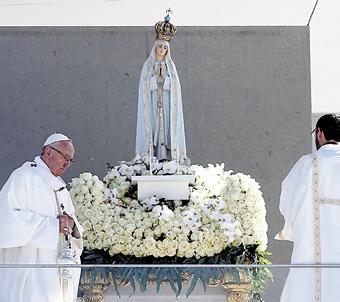
In an interview with the Italian state television network, RAI, broadcast June 4, the pope said Marian apparitions are “an instrument of Marian devotion that is not always true” and may be used to focus on or promote an individual.
“There have been true apparitions of Our Lady, but always with her finger like this, to Jesus” he said pointing outward, “never has Our Lady drawn (attention) toward herself when (the apparition) is true, she has always pointed to Jesus.”
Pope Francis said that a Marian devotion that becomes “too centered on itself” and lacks guiding people to Jesus “is no good, be it in the person that has the devotion or those who carry it forward.”
Through an observatory body overseen by the Pontifical International Marian Academy, the Vatican tracks alleged Marian apparitions around the world and studies their authenticity. During his upcoming trip to Portugal Aug. 2-6, Pope Francis will travel to a shrine honoring the apparitions at Fátima in which Mary appeared to three Portuguese children in 1917. Public devotion to Our Lady of Fátima was approved by the local bishop in 1930 and has since been promoted by the Vatican.
In the interview, the pope said that it was his grandmother who first talked to him about Mary when he was a boy in Argentina, but “always with Jesus at the center.” He said he was taught that “Mary was the one who brought Jesus into the world and Joseph watched over Him.”
The weekly Sunday religious TV program titled “A Sua Immagine” (“In His Image”), which Pope Francis has occasionally referenced after praying the Angelus in St. Peter’s Square, presents human interest stories of faith. During the hour-long episode with Pope Francis, he listened to an Olympic gold medalist, a prison chaplain, an engineer turned religious sister and a girl who overcame bullying in her school.
“There are certain people who find pleasure in torturing (others),” the pope told her. “We see it in wars, in videos of the war, the pleasure of so many soldiers, or others working there, in torturing a Ukrainian soldier, and often this happens with children.”
“With peace you always gain, maybe little, but you always gain,” the pope said. “With war you lose everything – everything – and the so-called gains are losses,” he said before pointing to screens showing destruction from war.
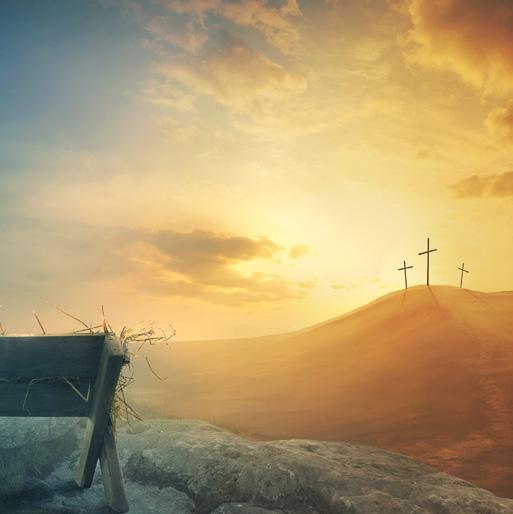
Pope Francis said the interview was the first time he had visited a television studio, aside from a “tiny” one in the Archdiocese of Buenos Aires.
Asked what he used to watch on TV as a child, the pope smiled and said: “I’ll tell you a secret, when I was young there was no television yet.”
joy, prosperity, and success Let
commitment
protecting
dignity and helping people facing displacement rebuild their lives
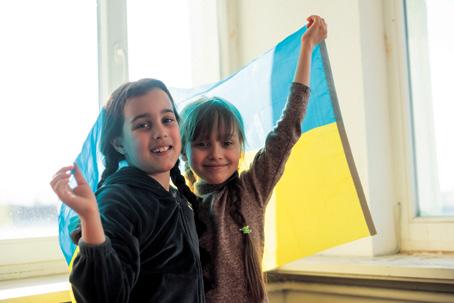
For the latest news 24/7: catholicnewsherald.com
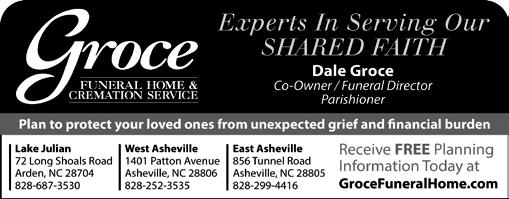
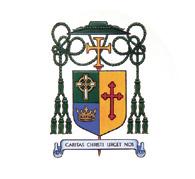

VATICAN CITY — Pope Francis was scheduled to undergo surgery at Rome’s Gemelli hospital June 7 to treat a hernia that had developed at an incision of a previous operation, the Vatican said. The pope was to be put under general anesthesia and undergo abdominal surgery involving “plastic surgery on the abdominal wall with prosthesis,” Matteo Bruni, director of the Vatican press office, said in a brief statement released shortly after the pope’s morning general audience June 7. He was expected to remain in the hospital for several days. The operation, “agreed upon in recent days by the medical team assisting the Holy Father, has
become necessary due to an incisional hernia” causing “recurring, painful and worsening” intestinal blockage, the statement said. An incisional hernia might occur at the site of an incision in the abdominal wall. The pope briefly visited the Gemelli hospital’s geriatric medical center for a medical checkup and tests June 6.
MANAGUA, Nicaragua — Nicaragua has frozen the bank accounts of dioceses nationwide as the regime of President Daniel Ortega escalates its persecution of the Catholic Church with accusations of theft and money laundering. The country’s banking regulator also requested of the Nicaraguan bishops’ conference and Cardinal Leopoldo Brenes of Managua “the presentation of the documents that show the movements of the dioceses’ bank accounts so that the laws of the country are complied with at all times, avoiding the illegal acts that have been committed,” according to a May 27 statement
The Most Reverend Peter J. Jugis Bishop of Charlotte requests the honor of your presence at the Liturgy of Ordination to the Holy Priesthood
Reverend Mr. Christopher Anthony Brock
Reverend Mr. Chukwunonso Arthur Nnebe-Agumadu
Reverend Mr Peter Michael Rusciolelli
Saturday, the seventeenth day of June Two thousand twenty-three at ten o’clock in the morning Saint Mark Catholic Church
from the National Police. The statement describes Cardinal Brenes as “Head of the Nicaraguan church.” The independent newspaper Confidencial wrote that the frozen accounts were first reported in the Diocese of Estelí, where imprisoned Bishop Rolando Álvarez of Matagalpa is apostolic administrator. Bishop Álvarez was sentenced to 26 years in prison in February after a sham trial on charges of undermining national sovereignty and spreading false information. Two priests there, Fathers Eugenio Rodríguez Benavides and Leonardo Guevara Gutiérrez, were detained May 20 and May 22, respectively, and are being investigated for matters pertaining to a now-extinct Caritas chapter, according to a Diocese of Estelí statement.
BALASORE, India — Government authorities June 4 were working to get rail services back in operation in the district of Balasore after the
deadliest train crash in India in decades killed 275 people and injured at least 1,000 June 2. At the Vatican, Pope Francis during his Sunday Angelus remembered the victims of a crash that involved three trains. “May our heavenly Father receive the souls of the deceased into his kingdom,” he said, echoing a papal telegram sent to the apostolic nuncio of India. The pope June 4 also assured the injured he is close to them and their families. CNN and other news outlets reported June 4 that the death toll was lowered to at least 275, after officials found that some victims had been counted twice during the chaos that followed the crash. The number of injured was reported variously as about 900, more than 900 and at least 1,000. Two days after the crash, news outlets were consistently reporting at least 1,000 injured. By June 4 rescue efforts had ended and the derailed cars had been removed from the tracks. The crash occurred in Odisha state in eastern India about 137 miles southwest of Kolkata, the home of St. Teresa and her Missionaries of Charity. Kolkata is in the neighboring state of West Bengal.



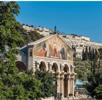

14-days: March 3 to 16, 2024 Dear

Schizophrenia is a serious and potentially deadly mental illness.
Spiritual schizophrenia is also very serious.
How often have you found yourself in a quandary, trying to decide between one voice in your head telling you one thing, and a different voice in your head telling you something else?
The Mayo Clinic website describes schizophrenia as “a serious mental disorder in which people interpret reality abnormally. Schizophrenia may result in some combination of hallucinations, delusions, and extremely disordered thinking.” It goes on to say, “People with schizophrenia require lifelong treatment. Early treatment may help get symptoms under control before serious complications develop and may help improve the long-term outlook.”
Schizophrenia is rare, affecting only about 0.32 percent of the population. One of its most common manifestations is hearing voices that don’t actually exist. These voices are hallucinations. My heart goes out to anyone who struggles with this or any mental health condition and to those who have loved ones who do.
With that said, I do believe that nearly 100 percent of the population suffers from some form of spiritual schizophrenia. I call it “spiritual schizophrenia” because we all hear competing voices in our head when making decisions. The difference between it and schizophrenia is the fact that the many voices we hear in our head actually exist.
Satan’s voice is real. He is a liar and a master illusionist. He tries to make everything seem different than it is. He attempts to create a hallucinogenic reality. He wants us to hear his voice and believe it’s God’s voice. He wants us to see good as bad and bad as good. He wants us to feel condemned when God wants us to feel loved. It is delusional to believe that we can do something sinfully wrong and expect God to see it as something right. And it would be disordered thinking to believe we can modify the teachings of the Bible to accommodate our own modern-day whims and desires without serious consequences.
Jesus tells us in John 10:4-5 that He is the Good Shepherd. He says His sheep follow Him because they recognize His voice. Do we truly recognize Jesus’ voice, or do we get tricked by the voice of the evil one?
We are more likely to follow the Good Shepherd if we spend time learning to discern His voice. Knowing God’s voice is something most people struggle
Father Jeffrey Kirby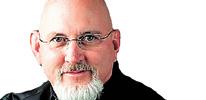
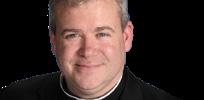
with. Many voices compete for our attention. We hear voices on the news, the voices and opinions of our friends, the voices of our culture, the voices of our flesh and the voices of evil. How do we distinguish God’s voice from these other voices?
God speaks to us in many ways, but the one place He is always speaking to us is in our conscience. This voice is always calling us to love and to do what is good and to avoid evil. We hear this voice with our heart, not our ears. This voice, inscribed in our heart by God, is our sanctuary. There we are alone with God, whose voice echoes in the depth of our being. God does not compel us to follow this voice. He gives us choice and free will to follow whatever voice we choose.
Learning to recognize God’s voice is a lifelong process. The more we hear it, the easier it is to recognize it again. Developing a good moral conscience takes time and effort. Our conscience bears witness to God’s authority, and it welcomes the commandments.
In order to hear God speaking through our conscience, we need to be present to ourselves. This requires time for self-reflection and self-examination.
Unfortunately, sometimes we listen to the wrong voices and make the wrong decisions. Even with the best formed conscience, we still fall into sin. The moment we fall, the voices in our head once again compete for attention.
After a fall, God speaks to us through our conscience, He calls us to repentance. His is a message of forgiveness, mercy and hope. His is a soothing, calming and liberating voice. Through faith, prayer and scripture, we will learn to recognize God’s voice.
Satan, on the other hand, speaks with an accusing voice. After convincing us to sin, he speaks words of condemnation. He tells us we are worthless and trapped by our sinfulness.
We all hear competing voices. Listening to the wrong voice can have deadly eternal consequences. Satan works hard to delude us.
How is Satan speaking to you? How is God speaking to you? How do you discern one voice from the other?
Just as with schizophrenia, our spiritual life requires lifelong treatment, and early treatment will help us get our symptoms under control. Today is a great day to start.
BRIAN PUSATERI, founder of 4th Day Letters and Broken Door Ministries, is a Catholic author and speaker. This was previously published at brokendoorministries.com.
This month, we honor the Sacred Heart of Jesus Christ. We are told by our society, however, that this month is about pride. It’s not a reference to the chief of the seven deadly sins, but rather to the promotion of lesbian, gay, bisexual, transgender and queer ways of life. The LGBTQ+ movement has claimed June for itself, as it claims that “love is love.”
Love recognizes observable realities, such as two sexes given at birth and the beautiful complementarity between men and women. Love accepts its call to selfdonation. It embraces the guidance of truth and understands its vocation to die to itself in service to the one who is loved.
Love does not serve pleasure, but goodness. It seeks the good in the one who is loved and is willing to deny itself in order to allow the good in the other to grow and prosper.
For the Christian, this universal truth is displayed in the crucifixion of the Lord Jesus. The Lord loved us and so offered Himself as a sacrifice for us, that the good in us might flourish even into eternal life.
St. John teaches us this point in his First Letter:
“We know love by this, that (Christ) laid down His life for us – and we ought to lay down our lives for one another.”
Truth directs love and matures it. In this way, boundaries and limits that are given to love are not hindrances to it. They are signposts and springboards to a deeper, authentic love. They caution love against selfishness and reorient any misdirection to nobility and moral goodness.
It is no small irony that the month claimed by this movement, and its incomplete and loose definition of love, is the very month in which we pause and honor the divine love of the Lord Jesus for every man and woman. It would seem, therefore, that we need to review what love is, what it is not, and how we can authentically receive and give love to others.
The secular version of love assumed in the messaging of the LGBTQ+ movement is deceptive and has convinced many people, even Christian believers, to go along with its fallen agenda. Since we were made for love and cannot live complete lives without love, the argument is made that sexual love must be open to all and cannot have any restrictions imposed upon it. We are told that sexual love must be given free reign and is best expressed when there are no boundaries or limits.
Regrettably, the world’s concept of love is seen as euphoria or emotional satisfaction as well as sexual gratification.
Such a minimalistic view of love robs the human heart of its excellence. It manipulates the heart to comply with lies. It blurs necessary distinctions and leads us into ways of life that lessen our capacity to truly love, care for others, and enjoy relationships of mutual selflessness and service.
Breaking through the jargon, slogans and popular messaging of the LGBTQ+ movement, we can begin by making the simple statement: Love tells the truth. As truth guards our hearts and helps us to know reality and right from wrong, so the heart protects truth by acknowledging it, speaking it, sharing it, and seeking to order its power to love according to truth’s guidance.
As spiritual wisdom teaches us, the emotions are magnetic and energizing. They are great servants, but terrible masters. Truth helps to keep our emotions in check, therefore, and gives them the space to germinate and inspire true love and wholesome affection.
Rather than pride, love always chooses humility. Made in the image of God, we have the spiritual power to love others as God loves us. Such a love is willing to wash feet, be among the poor, kiss lepers, clothe the naked, visit the sick, generously give mercy, teach the uneducated, admonish the sinner, and suffer for the sake of righteousness.
As St. Paul teaches us in his First Letter to the Corinthians:
“Love is patient; love is kind; love is not envious or boastful or arrogant or rude. It does not insist on its own way; it is not irritable or resentful; it does not rejoice in wrongdoing, but rejoices in the truth. It bears all things, believes all things, hopes all things, endures all things.”
As we walk through the month of June, let us give witness to the Sacred Heart of Our Lord by welcoming His love in our hearts and kindly sharing that love with others.
In contrast to the propaganda of “Pride Month,” let us take pride in the example our Lord Jesus Christ gave us and show the world what true and authentic love and relationships look like by our efforts to embrace humility, honor moral goodness, discard quarrelsome spirits, and selflessly serve and care for those around us.
‘Love seeks the good in the one who is loved and is willing to deny itself in order to allow the good in the other to grow and prosper.’
“The struggle is real, but so is God.” This message appeared on the Instagram account of the supermodel Iman, in January of 2016, along with a single word: “Rise.”
It was her statement following the death of her husband, David Bowie. Its brevity was not surprising. The couple had always been private about their 24-year marriage. The forthright acknowledgment of the existence of God, however, might have confounded some,
where God was – how and why He mattered to a self-described “quiet little boy” who grew up feeling cold and alone – pursued Bowie. Perhaps a part of him knew he was being chased and, like a clever child playing hide-and-seek, enjoyed the concealment part while waiting to be found before nightfall.
We get a full picture of that needful boy in “Moonage Daydream,” a 2022 documentary on Bowie that is “narrated” entirely in his voice, using previously unreleased film footage and snips from interviews. From the opening we understand that Bowie was a man with a lot of questions that, at their core, were about God. “At the turn of the 20th century, Friedrich Nietzsche proclaimed that God is dead and that man had killed Him,” we hear him pronounce. “That led to a terrifying confusion: for if we could not take the place of God, how could we fill the space we had created within ourselves?”
The very young Bowie sought to fill the space through art. As an introvert, he settled on inhabiting characters through music and was quickly sucked into the disorienting 1970s music-industry vortex of endless drugs, outlandish material wealth and the mindless embrace of the creepy English occultist Aleister Crowley.
given the often dark and otherworldly musical personae that Bowie would slip into, and out of, throughout decades of artistic reinvention.
Born in 1947 as David Robert Jones, Bowie had been put through his faith-paces within the rites of the Church of England. A Trinitarian baptism leaves its mark, leaves one claimed for Christ, regardless of where one wanders. Under that sacrament the primary reality of God stays with you; the Hound of Heaven haunts you, no matter where how far you stray.
The opening of Francis Thompson’s poem by that name could have been a Bowie lyric:
I fled Him, down the nights and down the days;
I fled Him, down the arches of the years;
I fled Him, down the labyrinthine ways
Of my own mind…
It’s easy to imagine Bowie keening through the sentiments, surrounded by abstract or disturbing images. Right up to his death – and the release of “Lazarus,” his last musical and visual work (“Look up here, I’m in heaven …”) – Bowie kept us guessing what he was all about, largely because he seemed to be guessing too, ironic and naked in his wonderings.
Bowie did stray from the Hound, moving from Christianity to Eastern-Asian religions and eventually into the ruinously dark side of occultism – a spiritual slog that pressed against all social and moral constraints in an attempt to find the imagined endless “yes” of spiritual emancipation, away from the perceived endless “no” of Christianity.
In this sense, for all his originality, Bowie was very much part of a zeitgeist. Yet even as he strayed, the question of who and
“I fell into the trap of the black magic, cabalism … just the Crowleyism of, you know, for a significant time of that middle point of the ’70s,” a sober and healthy-looking Bowie told reporter Kerry O’Brien in 2004, “I’d really got completely disoriented … just an awful, dreadful period.”
Bowie admitted that amid the fame and “fortune” he didn’t know who God was, but he knew there was a God – a being, a great creator – whom he wanted to know.
Simply put, God is love. By all accounts when Bowie met Iman in 1990, he met love, and there he seems, finally, to have met God. If “Moonage Daydream” shows us the disorienting chaos in Bowie’s life, it also reveals the clarifying light that settled on Bowie once the Hound of Heaven had caught him and delivered him, willingly, to love, which cast the darkness aside.
Baptized as a boy, sealed for Christ, did Bowie die a settled Christian or was he still journeying?
Probably we will never know. While filming “The Man Who Fell to Earth,” Bowie alluded to having encountered an “ultimate evil” and thereafter wore a small cross around his neck for the rest of his life. He and Iman, who is Muslim, were married in a traditional Episcopalian ceremony, Bowie explaining, “our real marriage, sanctified by God, had to happen in a church.”
We are, all of us, mysteries. But God always gives chase and never gives up.
In “Moonage Daydream” David Bowie gives an almost accidental testimony to the futility of running, and the gentling power of light over darkness, when love is finally found.
ELIZABETH SCALIA is culture editor for OSV News. Follow her on Twitter @theanchoress.

Pope Francis
From online story: “Pope asks Catholics to welcome everyone, create communion”
The Catholic News Herald reached the Facebook and Instagram feeds of more than 112,000 people in English and Spanish last month. The most talked about post? Coverage of the newly ordained deacons. Join the conversation: www.facebook.com/CatholicNewsHerald
On YouTube in May so far, videos produced by the Catholic News Herald have been viewed more than 21,900 times. The most watched video? Christ the King’s Miguel Villalobos sings “Ave Maria.”
Through press time on June 7, 37,092 visitors to www.catholicnewsherald.com have viewed a total of 54,990 pages. The top five headlines in May and June so far have been:
n One step closer to the priesthood, seven men ordained deacons............................................ 1,701
n Mary, Mother of the Church 1,044
n Atlanta archbishop to preside on behalf of Bishop Jugis at upcoming ordinations 1,023
n 2023 summer assignments for seminarians announced............................................................ 854

n Diocese of Charlotte Catholic schools honored with national award 691
The Catholic News Herald welcomes letters from readers. We ask that letters be originals of 250 words or fewer, pertain to recent newspaper content or Catholic issues, and be written from a perspective of Christian charity.
To be considered for publication, each letter must include the name, address and daytime phone number of the writer for purpose of verification. Letters may be condensed due to space limitations and edited for clarity, style and factual accuracy.
The Catholic News Herald does not publish poetry, form letters or petitions. Items submitted to The Catholic News Herald become the property of the newspaper and are subject to reuse, in whole or in part, in print, electronic formats and archives.
E-mail: catholicnews@charlottediocese.org
Mail: Letters to the Editor Catholic News Herald 1123 S. Church St. Charlotte, N.C. 28203
‘Our God is a communion of love: and this is how Jesus revealed Him to us.’
Amid the fame and ‘fortune’ David Bowie didn’t know who God was, but he knew there was a God whom he wanted to know.
Elizabeth Scalia
